EDITOR’S NOTE: Please be advised that this Santiago de Compostela travel guide hasn’t been updated in 2025. Prices and travel guidelines may no longer be accurate so it’s important that you verify any information before proceeding.
When you think of Santiago de Compostela, the first thing that comes to mind is the camino. It’s the final destination in the Camino de Santiago or the Way of St. James, a network of routes all leading to the city’s massive cathedral.
Completing the full camino is one of the few things left on my travel bucket list. Until then, I’m not qualified to offer any advice on it, so this guide is more for people wanting to visit Santiago de Compostela as non-pilgrims. (Personally, we went for the percebes.)
Aside from being the end point of the camino, there are other things to enjoy about this holy city that we felt was one of the most atmospheric and architecturally impressive cities we visited in Spain.
VISIT SANTIAGO DE COMPOSTELA QUICK LINKS
This travel guide to Santiago de Compostela is long. For your convenience, I’ve compiled links to hotels, tours, and other services here.
HOTELS
- Luxury: Parador de Santiago – Hostal Reis Catolicos
- Midrange: Hotel San Miguel
- Budget: Albergue Monterrey
TOURS
- Sightseeing Tour: Cathedral and Museum Guided Tour
- Day Trip: Rías Baixas: Boat Trip, Mussels, Wine, and Winery Visit Tour
OTHER SERVICES
- Visa Services
- Travel Insurance with COVID cover (WFFF readers get 5% off)
- Car Rental
- Spain eSIM
Save This on Pinterest!
No time to read this Santiago de Compostela Travel Guide now? Click on the save button and pin it for later!
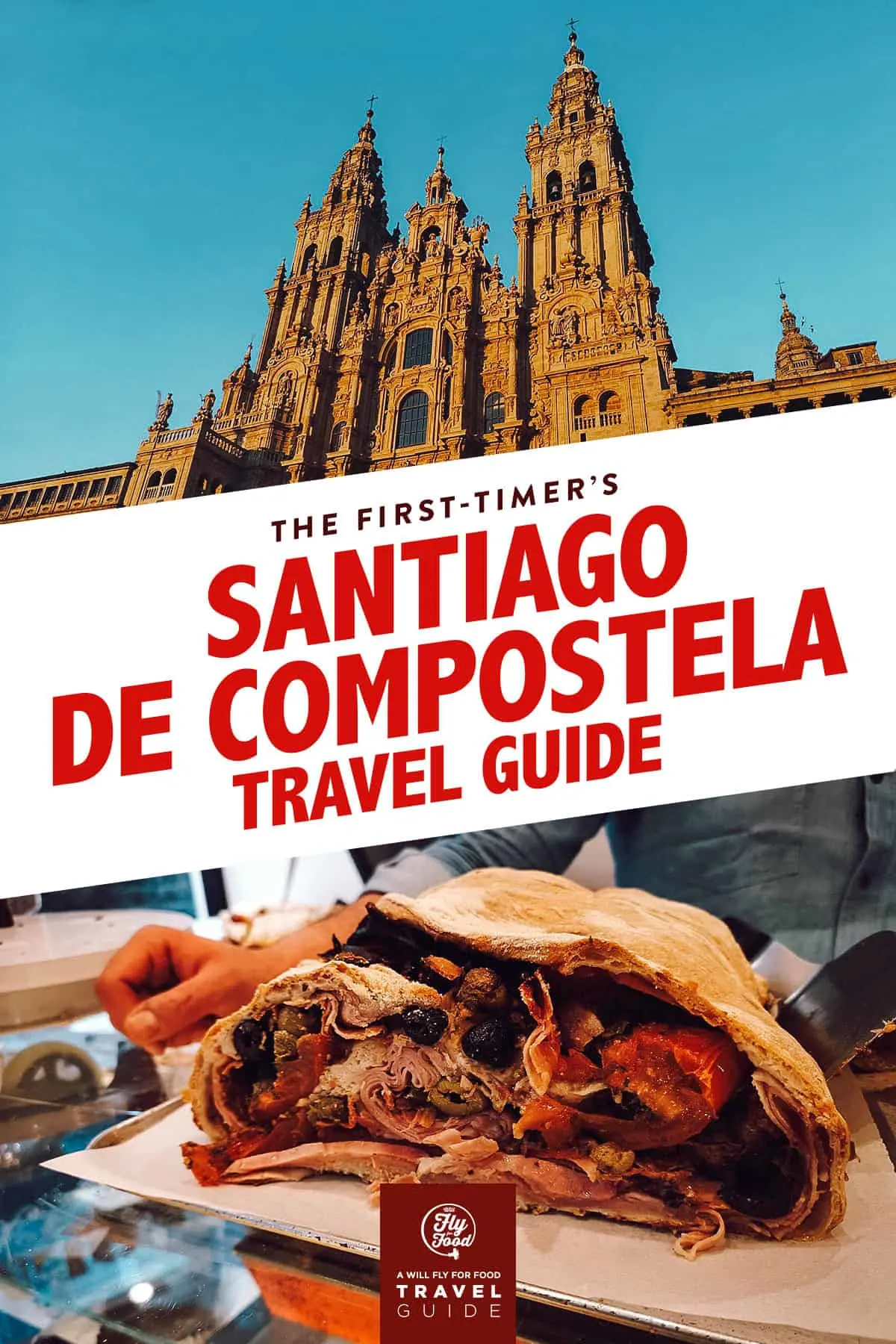
GUIDE TABLE OF CONTENTS
SANTIAGO DE COMPOSTELA TRAVEL RESTRICTIONS
Because of the current global situation, Santiago de Compostela travel guidelines change almost on a daily basis. Our friends at Booking.com created a website that lists detailed information on travel restrictions around the globe.
Before planning a trip to Santiago de Compostela, be sure to check Booking.com for information on travel restrictions to Spain. If you do decide to visit Santiago de Compostela, then you may want to seriously consider getting travel insurance with COVID coverage.
SPAIN VISA
Depending on your passport, you may need a visa and other requirements to visit Spain. Check out iVisa.com to learn about the requirements and to apply for a visa (if necessary).
SANTIAGO DE COMPOSTELA AT A GLANCE
Santiago de Compostela is the capital of Galicia and its most visited city. It’s one of the most sacred places in Catholicism because it’s believed to be the final resting place of St. James, one of the twelve apostles of Christ.
It’s believed that St. James preached the gospel in present-day Galicia. He returned to Jerusalem only to be beheaded by King Herod in 44AD. His devotees returned his remains to Galicia where they remained undiscovered until 813.
News of the discovery reached Alfonso II, the king of Asturias, who immediately made the journey to Compostela. His pilgrimage to Santiago is recognized as the camino’s first, and it became the blueprint for the route known today as the Camino Primitivo (Primitive Way).
This led to the construction of a religious monument and marked the beginning of Santiago de Compostela and the Camino de Santiago. Today, hundreds of thousands of pilgrims do some version of the camino every year.
BEST TIME TO VISIT SANTIAGO DE COMPOSTELA
The vast majority of pilgrimages take place between April and October when the weather is ideal. If you aren’t doing the camino, then it matters less when you go but it’s still best to visit when the weather is nice.
We were in Santiago de Compostela in early May and the city was starting to receive a good number of pilgrims and tourists, but it wasn’t unpleasant. June till August are the most popular camino months so I think it’s best to go in Apr-May or Sept-Oct.
DEC-FEB: Winters in Galicia are relatively mild but it can get also get fairly cloudy, rainy, and windy. Weather-wise, this isn’t the best time to go.
MAR-MAY: It can still be cool and rainy in March but April and May are among the best times to be in Santiago de Compostela.
JUN-AUG: The summer is peak season and the hottest time of the year. If you’d like to avoid the crowds and the heat, then it’s best to go immediately before or after summer.
SEPT-NOV: Like spring, autumn is another great time to be in Santiago de Compostela. Personally, I plan on doing the Camino Frances in September 2022.
Climate: Annual Monthly Weather in Santiago de Compostela
For your convenience, I’ve created the average temperature and annual rainfall graphs below with the most ideal months to visit marked in orange.
Average Temperature
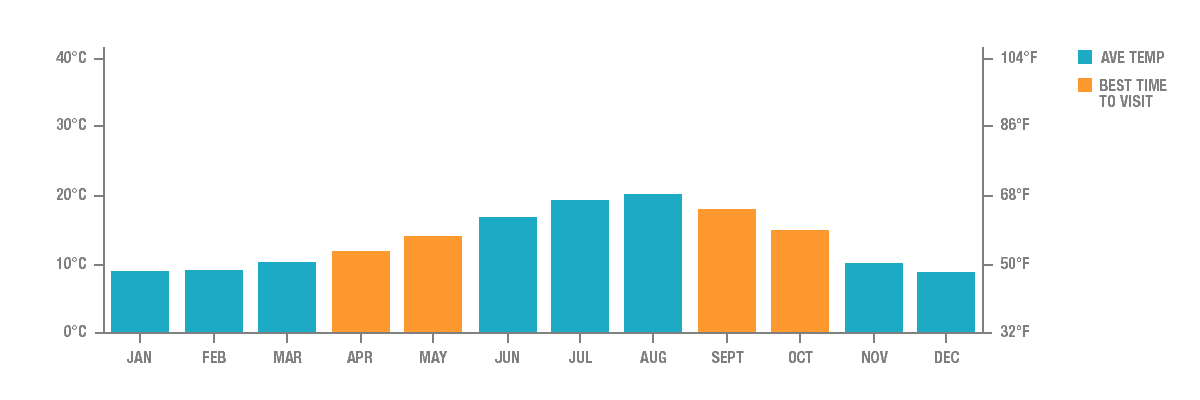
Annual Rainfall
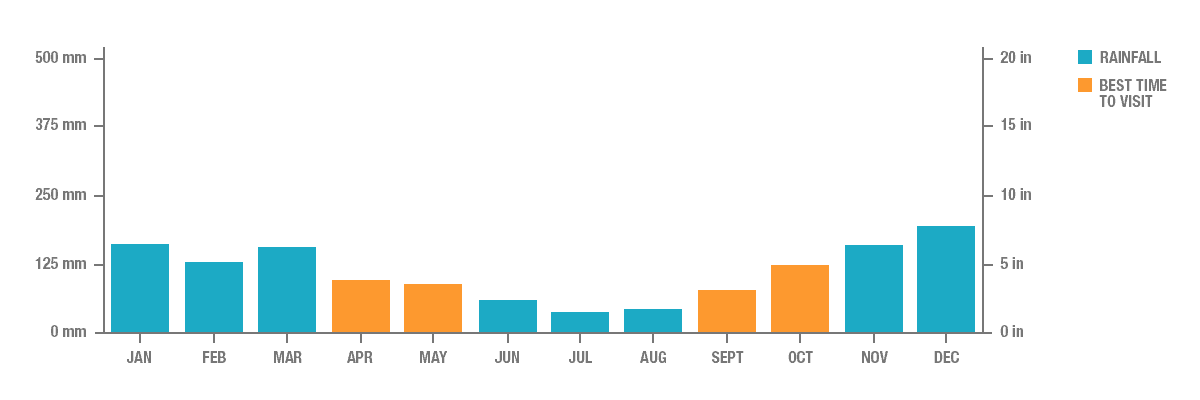
TRAVELING TO SANTIAGO DE COMPOSTELA
We drove from San Sebastian to Santiago de Compostela but there are many ways to get there depending on where you are.
BY PLANE: People flying in to Santiago de Compostela will arrive at Santiago–Rosalia de Castro Airport (SCQ). It’s about 15 km (9.3 miles) east of the city so you can either take a taxi or a bus to the city center.
BY TRAIN: If you’re in a city relatively near Santiago de Compostela, then traveling by train may be the better option. You can check for train routes and buy tickets on Trainline. The Santiago de Compostela railway station is only about 1.5 km (0.9 miles) from the city center so it’s possible to walk to your hotel. Otherwise, you can take a taxi.
BY BUS: Traveling by bus is another good option. You can check for bus routes on Alsa. We took an Alsa bus from Santiago de Compostela to Porto. The bus station is located fairly close to the city center, about 1.5 km away, so it’s possible to walk (we did). Otherwise, you can take a taxi to your hotel.
BY CAR: Traveling by car is perhaps the best way of experiencing Spain and many parts of Europe. As described, we drove from San Sebastian to Santiago de Compostela. Unlike public transportation, it gave us the freedom to stop wherever and whenever we wanted. If you’d like to rent a car, then you can do so on Rentalcars.com.
WHERE TO EXCHANGE CURRENCY
The unit of currency in Spain is the Euro (EUR).
I withdrew EUR from an ATM so I didn’t have to exchange currency in Santiago de Compostela. This seems to be the norm in many parts of Europe these days. ATM rates are competitive and you don’t have to bring as much foreign currency with you.
If you plan on using your ATM card abroad, then it’s best to inform your bank beforehand. That way they don’t flag any transactions made in Europe. In my experience, my ATM card works in most machines but not in others. I didn’t have any problems in Spain.
NOTE: Some ATMs may ask if you’d like to proceed “with or without conversion”. Always proceed WITHOUT conversion. Proceeding with conversion authorizes the foreign bank operating the ATM to do the conversion for you, usually at unfavorable rates.
BEST AREAS TO STAY IN SANTIAGO DE COMPOSTELA
If it’s your first time in Santiago de Compostela, then it’s best to stay in the Old Town.
It’s a relatively small area that’s closed off to vehicular traffic so it’s easy to get around on foot. Most of the city’s top attractions and restaurants are located in the Old Town.
We stayed at Hospederia Tarela, a lovely boutique inn about a 5-minute walk from the cathedral. Rooms and bathrooms are spacious and clean there’s a cafe on the first floor with indoor and outdoor seating.
You can book a room at Hospederia Tarela on Booking.com or Agoda. If you don’t feel this is the right hotel for you, then you can click on the links for alternate listings in Santiago de Compostela: Booking.com | Agoda. Check out some of the top-rated hotels in Santiago de Compostela:
- Luxury: Parador de Santiago – Hostal Reis Catolicos
- Midrange: Hotel San Miguel
- Budget: Albergue Monterrey
You can also book hotels and home stays in Santiago de Compostela using the handy map below.
PLACES TO VISIT IN SANTIAGO DE COMPOSTELA
The Old Town is compact so it’s easy to explore on your own. But if you’d like to have a guide explain everything to you, then you may be interested in booking a walking tour (Option 1 | Option 2).
Another option is to get a Compostela Pass Plus. It’s a tourist card that offers a number of perks like a guided tour of the Old Town, free entrance to the Cathedral’s museum, discounts to restaurants and day trips, and more.
1. Santiago de Compostela Cathedral
The Santiago de Compostela Cathedral is a breathtaking sight. It’s one of the most spectacular churches I’ve ever seen in my life and we visited quite a few in Spain alone. Walking onto Praza do Obradoiro and looking up at the massive cathedral for the first time will leave you breathless.
The tomb beneath the cathedral’s main altar is the reputed burial site of St. James. It’s the final destination of all caminos and is just one of three known churches built over the remains of an apostle. The other two are St. Peter’s Basilica in Vatican City and St. Thomas Cathedral Basilica in Chennai, India.
Praza do Obradoiro is where pilgrims celebrate the end of their camino. Caminos vary in length from 120 km (Camino Ingles) to 1,000 km (Via de la Plata) or longer. The sight of this magnificent monument at the end of such a long journey is a cause for celebration indeed.
Inside the cathedral is a long queue of pilgrims waiting to hug a statue of St. James. I fell in line without knowing what it was for until it was my turn to hug the statue. There’s an excellent museum inside the cathedral as well.
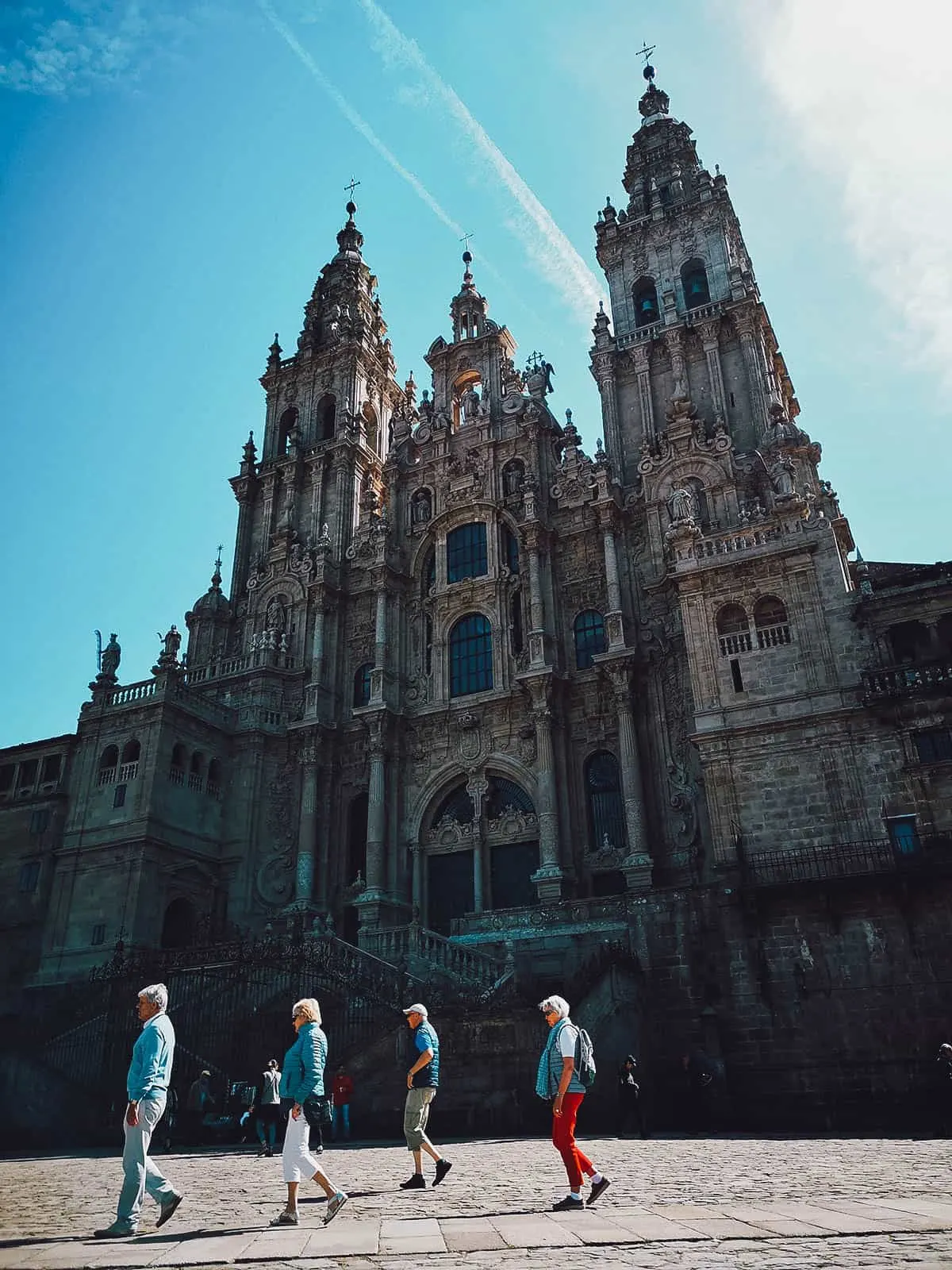
Operating Hours: 10AM-6:30PM, Mon-Sun (Oct-Jun), 10AM-8PM (Jun-Sep)
Admission: EUR 6 (museum)
2. Monastery of San Martiño Pinario
The monastery of San Martiño Pinario is a 16th century Benedictine monastery located right next to Santiago de Compostela Cathedral. It’s the second largest monastery in Spain after the Monastery of El Escorial outside Madrid.
Interestingly, part of the monastery has been converted into a hotel. You can book a room at Hospederia San Martin Pinario through Booking.com or Agoda. There’s a museum of religious art located inside the monastery as well.
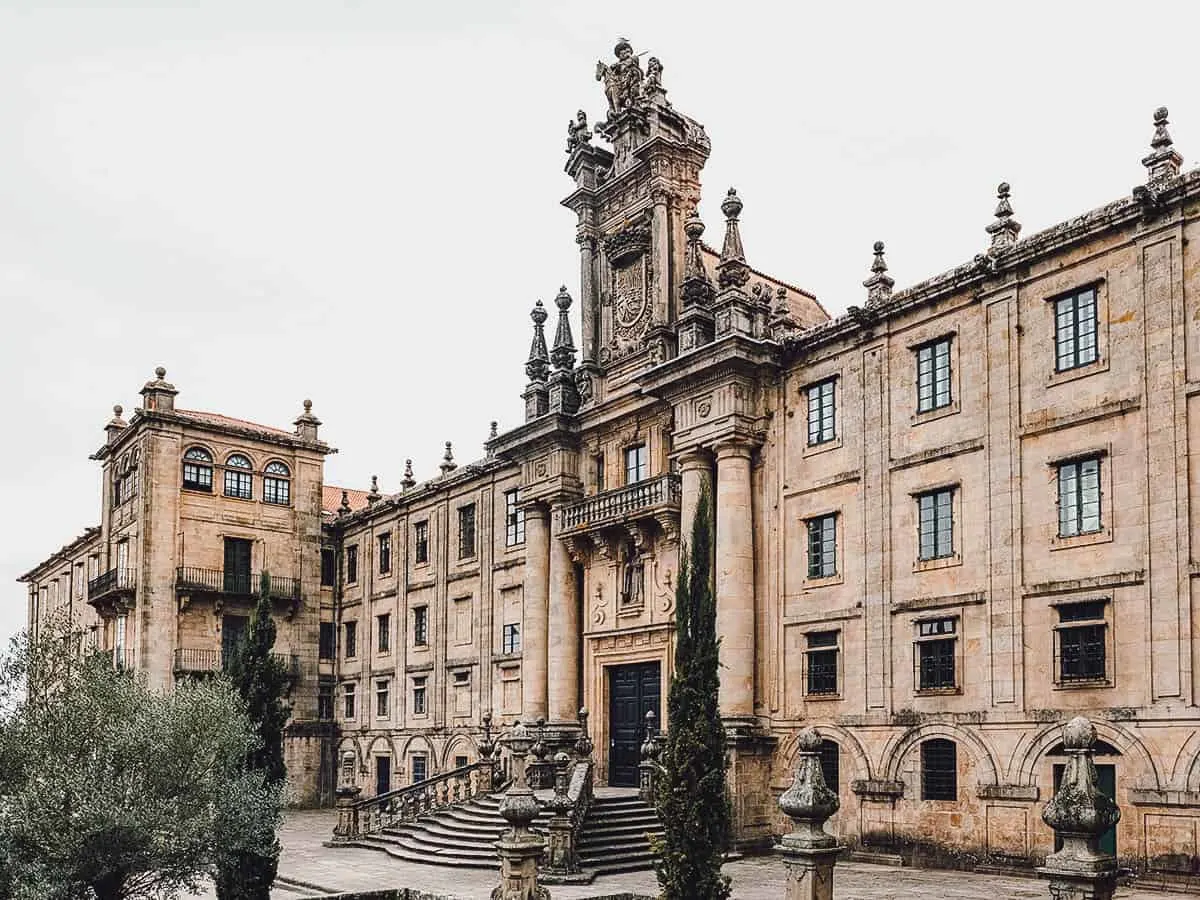
Photo by homydesign via Shutterstock
Operating Hours: 11AM-7PM (Nov-May), 10AM-8PM (Jun-Oct)
Admission: EUR 5 (church and museum)
3. Mosteiro de San Paio de Antealtares
The Monastery and Church of San Pelayo de Antealtares is an 11th century Benedictine monastery founded by Alfonso II. It was originally occupied by twelve monks who were tasked to look after the recently discovered tomb of St. James.
After the monks left the monastery in 1499, it was occupied by cloistered nuns who dedicated the convent to St. Pelayo, a Galician child martyred in Cordoba.
The nuns still live in the monastery and sell a variety of baked goods, including the city’s famed Tarta de Santiago. There’s a museum of religious art inside the monastery as well.
It looks empty now but this picture was taken from Praza da Quintana, one of the many busy but pleasant squares in the Old Town. The building with the large cross on its side is the monastery.
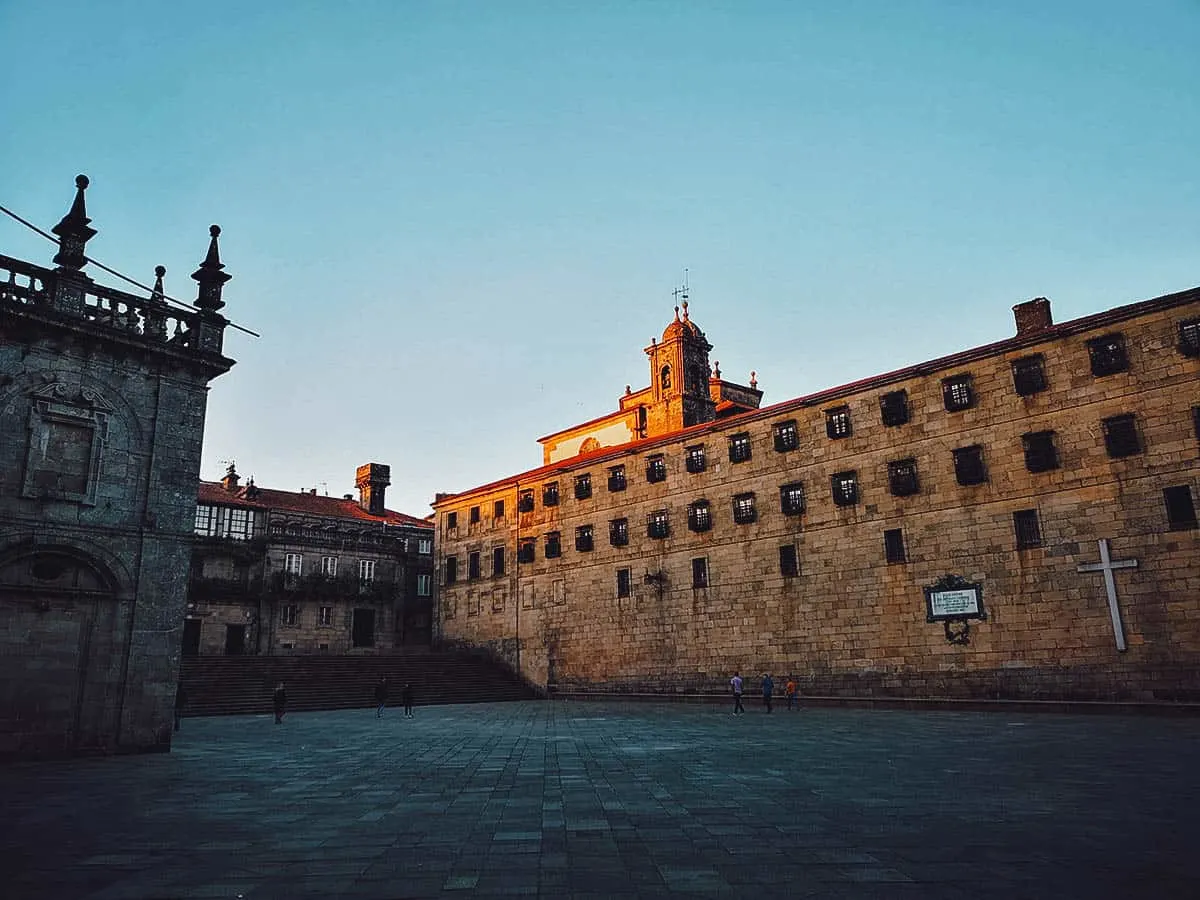
Operating Hours: 10:30AM-1:30PM, 4-7PM, Mon-Sat (closed Sundays)
Admission: EUR 3 (museum)
4. Convento de San Francisco de Santiago
The Convento de San Francisco de Santiago is a former convent that used to house Franciscan monks in the 18th century. The monks have since been moved to a more modern facility while the old convent has been converted into a 4-star hotel and restaurant.
It’s a beautiful building with an interesting museum, chapel, and a restaurant serving a pilgrim’s menu of typical convent or monastery dishes.
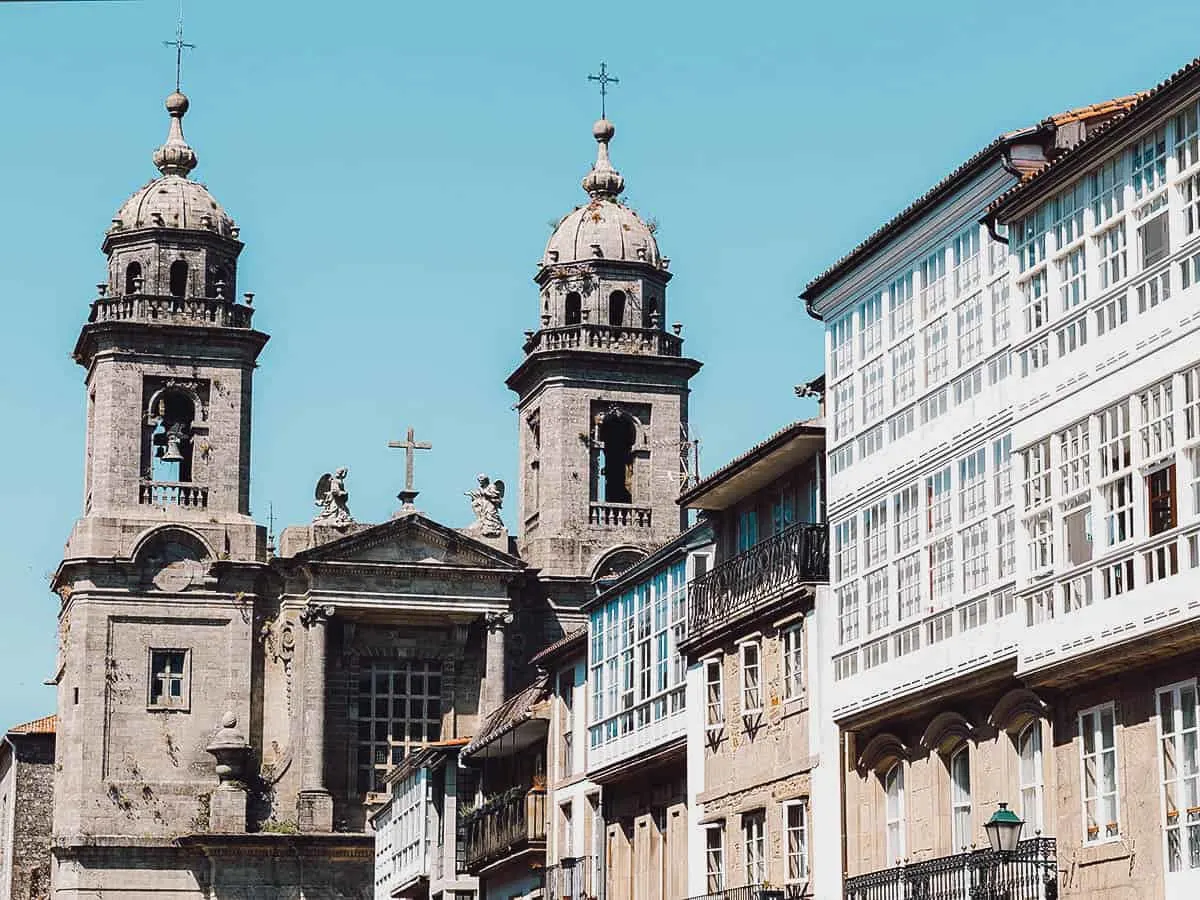
Photo by Salva G C via Shutterstock
Operating Hours: 10:30AM-1:30PM, 4-7PM, Thurs-Sun (closed Mon-Tue)
Admission: EUR 3 (museum)
5. Praza das Praterias
The Old Town isn’t that big but it has a good number of town squares that offer places to sit and do little more than while away the time. Praza do Obradoiro and Plaza de la Quintana are much larger but I enjoyed Praza das Praterias the most.
It’s a small square with a fountain in the middle and surrounded on all sides by awe-inspiring structures, none more magnificent perhaps than the Cathedral’s Torre da Berenguela.
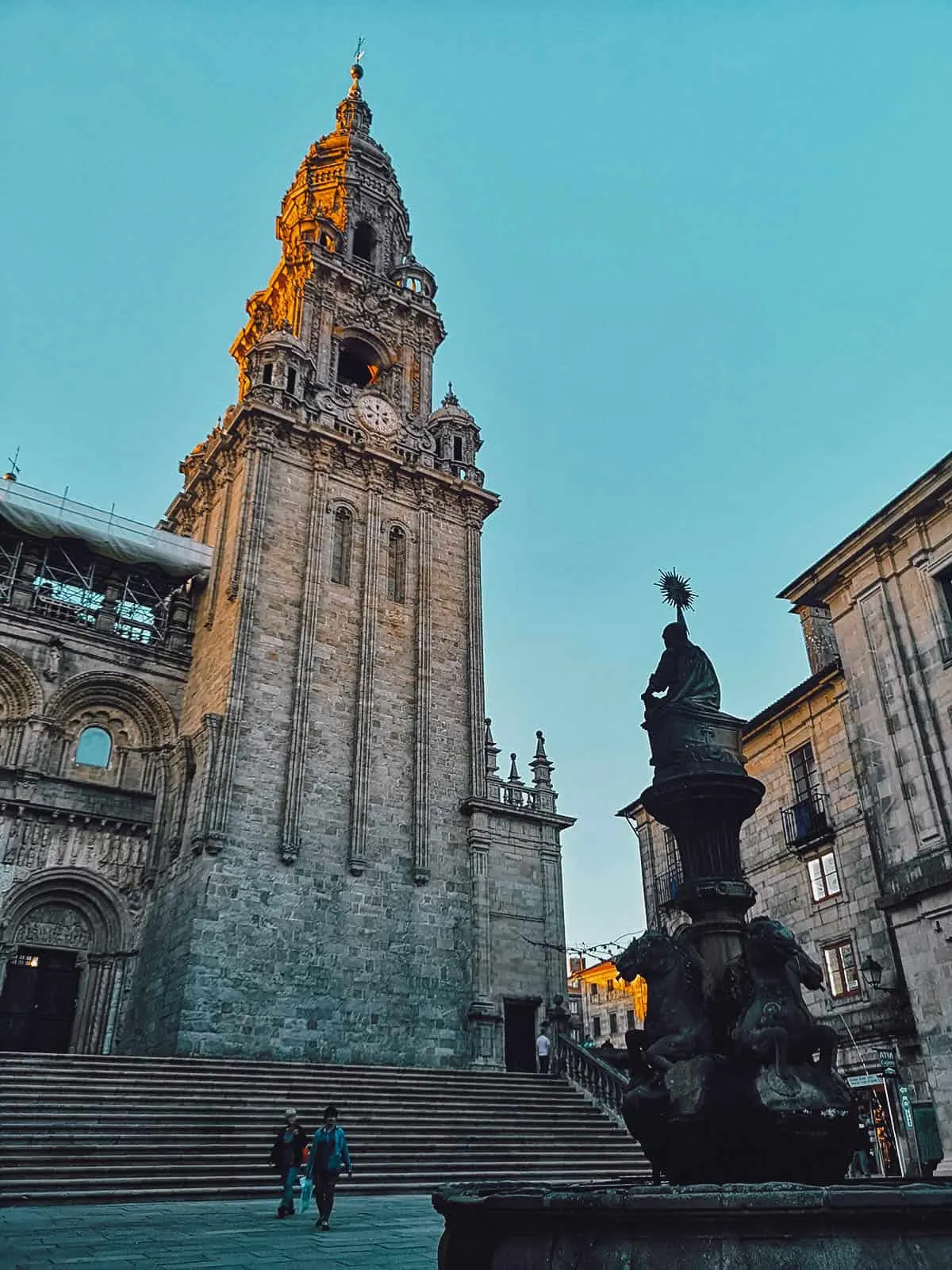
Praza das Praterias means “Square of the Silversmiths”. It got its name from all the silversmiths who’d set up shop at this square hundreds of years ago.
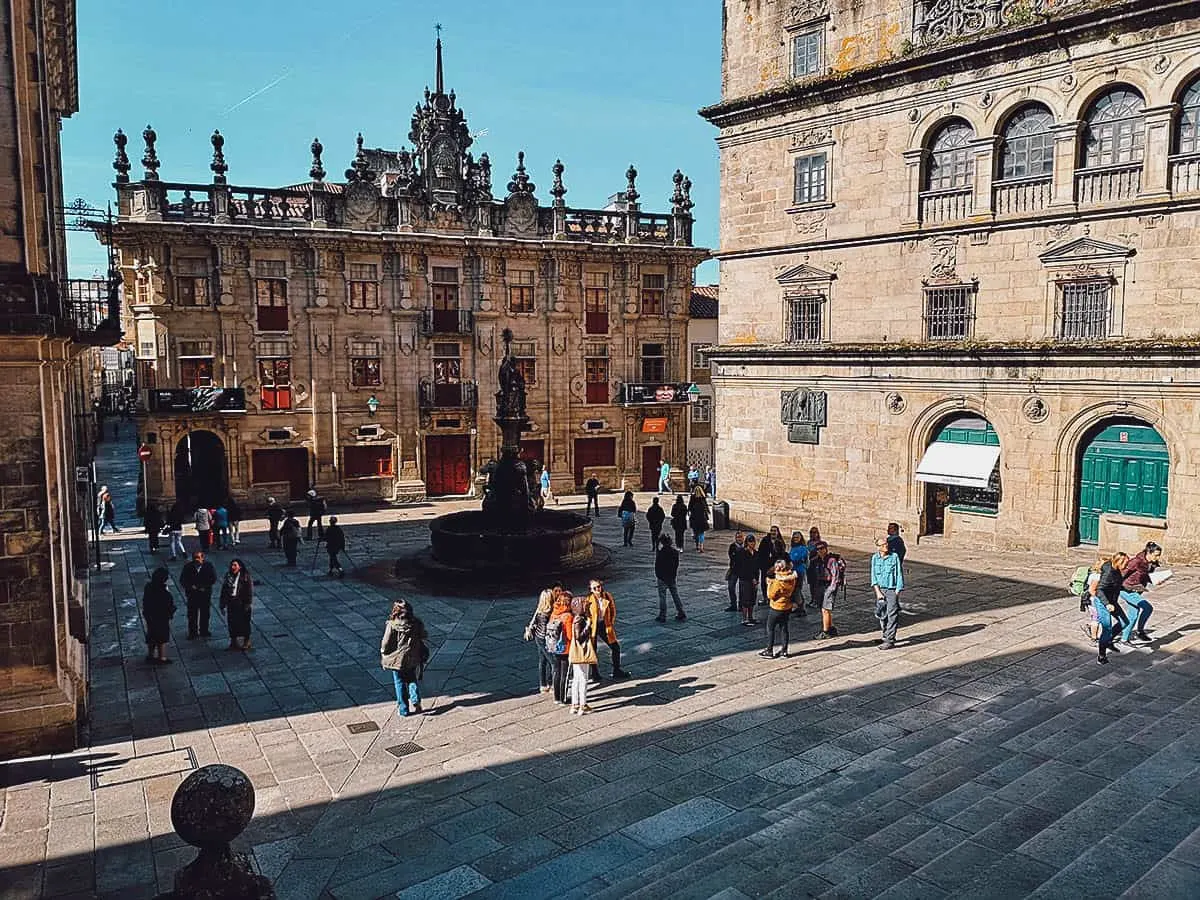
DAY TRIPS FROM SANTIAGO DE COMPOSTELA
1. Finisterre & Muxia
Finisterre and Muxia are coastal towns on the west coast of Galicia. They’re often the final destination of pilgrims who’ve reached the cathedral and completed the camino.
Finisterre or Fisterra is a fishing port well-known throughout Spain. It’s famous for its port area with cafe bars serving some of the freshest seafood in Galicia. Other points of interest include the Castle of San Carlos and the Farro de Fisterra (pictured below). After the cathedral, the lighthouse is described as the second most visited tourist destination in Galicia.
Interestingly, Finisterre means “end of the earth” or “land’s end”. It was once thought to be the westernmost point of continental Europe, though Cabo Touriñan and Cabo da Roca in Portugal are farther west.
Muxia is a similarly small and peaceful fishing village about 30 km (18.6 miles) north of Finisterre. It’s best known for the Nosa Señora da Barca, a stone church housing an image of the Virgin Mary. Legend has it that the image was given to St. James by the Virgin Mary after appearing to him in a vision.
Finisterre and Muxia are half an hour apart by car so they’re often visited on the same guided tour from Santiago de Compostela (Option 1 | Option 2 | Option 3).
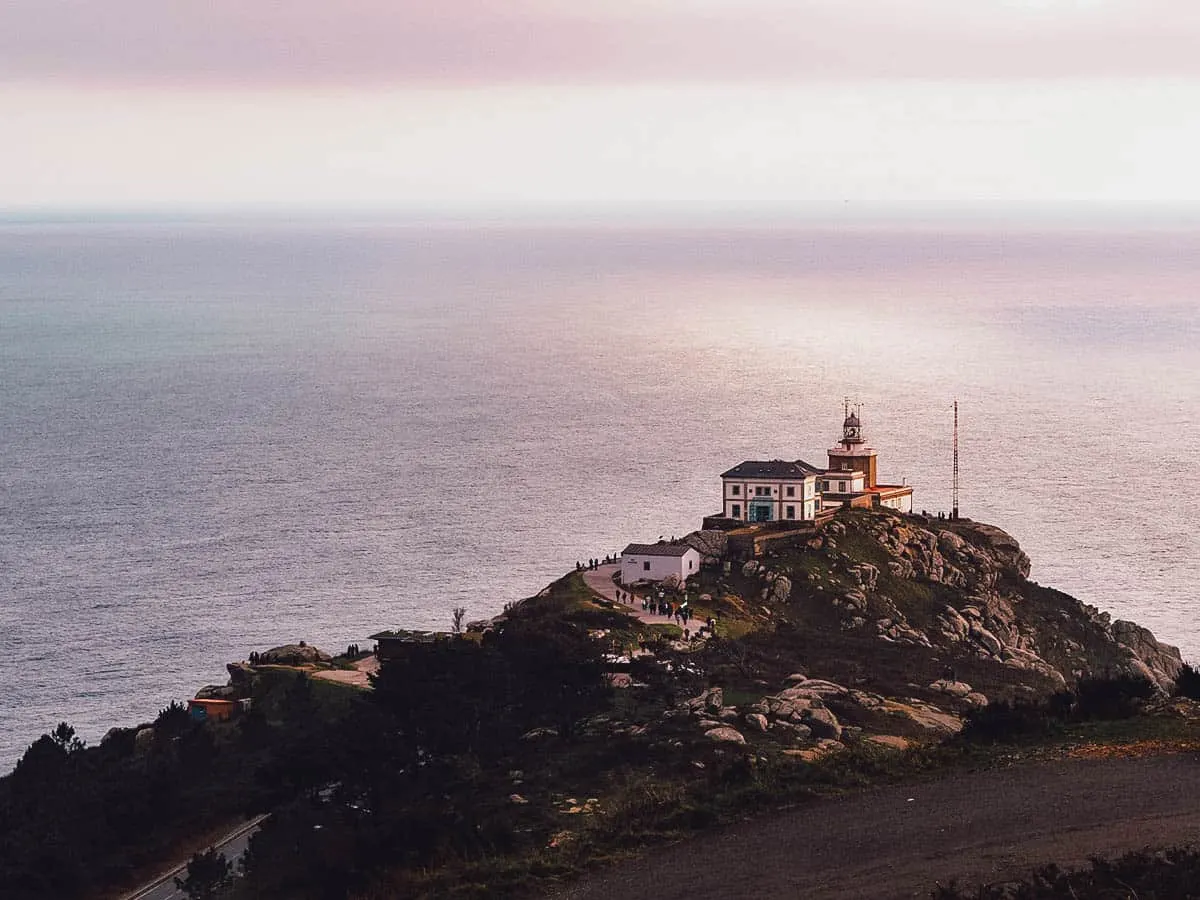
“Faro de Finisterre, A Coruña” by Gregorio Puga Bailon, used under CC BY 2.0 / Processed in Photoshop and Lightroom
2. Rias Baixas
Rias Baixas is one of Galicia’s most popular holiday destinations. It’s famous for its long sandy beaches and exceptional seafood, not to mention its wines. A Spanish Denominacion de Origen (DO) for wines, Rias Baixas is famous for its fragrant and fruity white wines made from Albariño grapes.
You can visit Rias Baixas by rental car or on a full-day guided tour from Santiago de Compostela (Option 1 | Option 2 | Option 3).
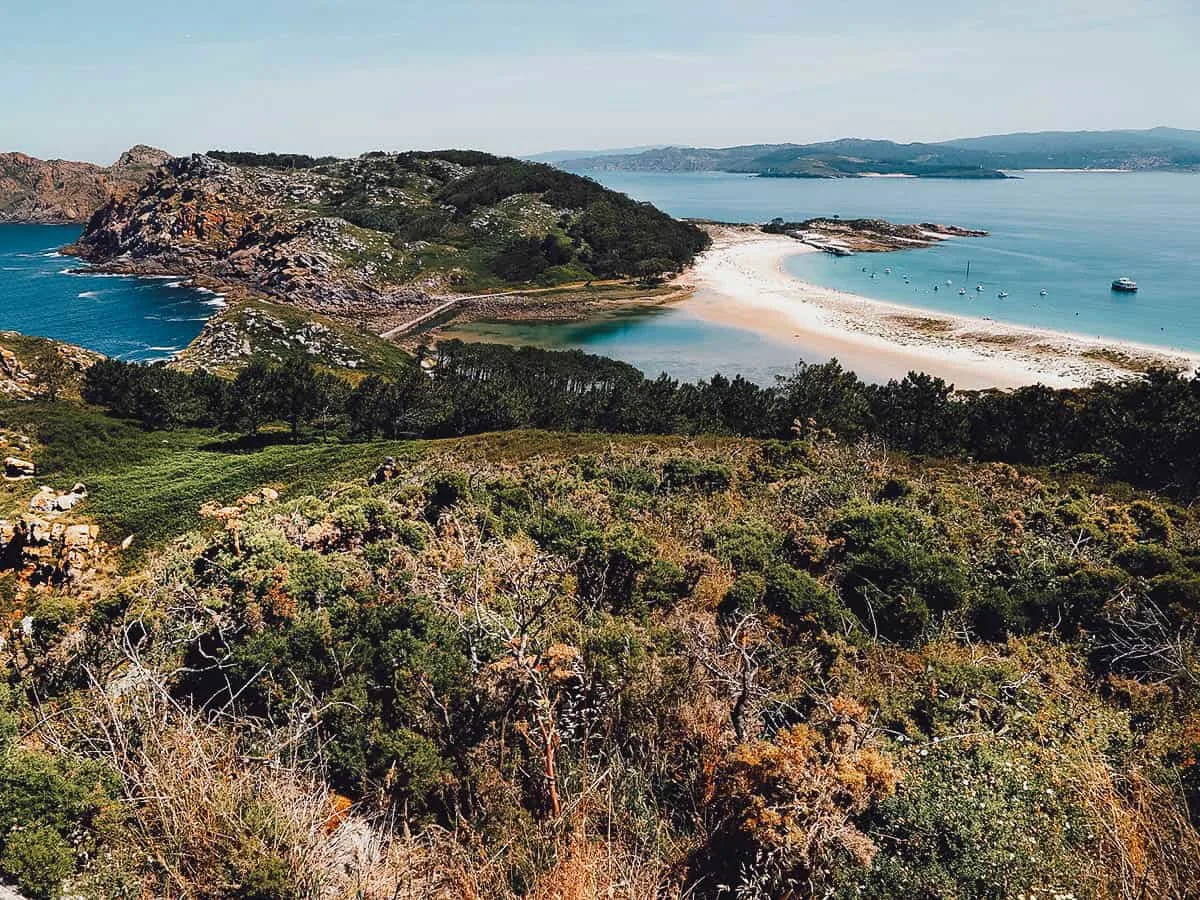
“Rias Baixas – Pontevedra” by Volkswagen España, used under CC BY 2.0 / Processed in Photoshop and Lightroom
3. Ribeira Sacra
Meaning “Sacred Shore”, Ribeira Sacra refers to an inland area in Galicia that borders the confluence of the Sil and Miño rivers. It’s famous for its medieval monasteries and spectacular gorge scenery with terraced vineyards perched precariously on the sides of steep slopes.
Like Rias Baixas, Riberia Sacra is a Spanish Denominacion de Origen (DO) for wines. It’s known for producing three wine varietals – red Mencia, white Albariño, and white Godello. It’s best explored by rental car or on a guided tour.
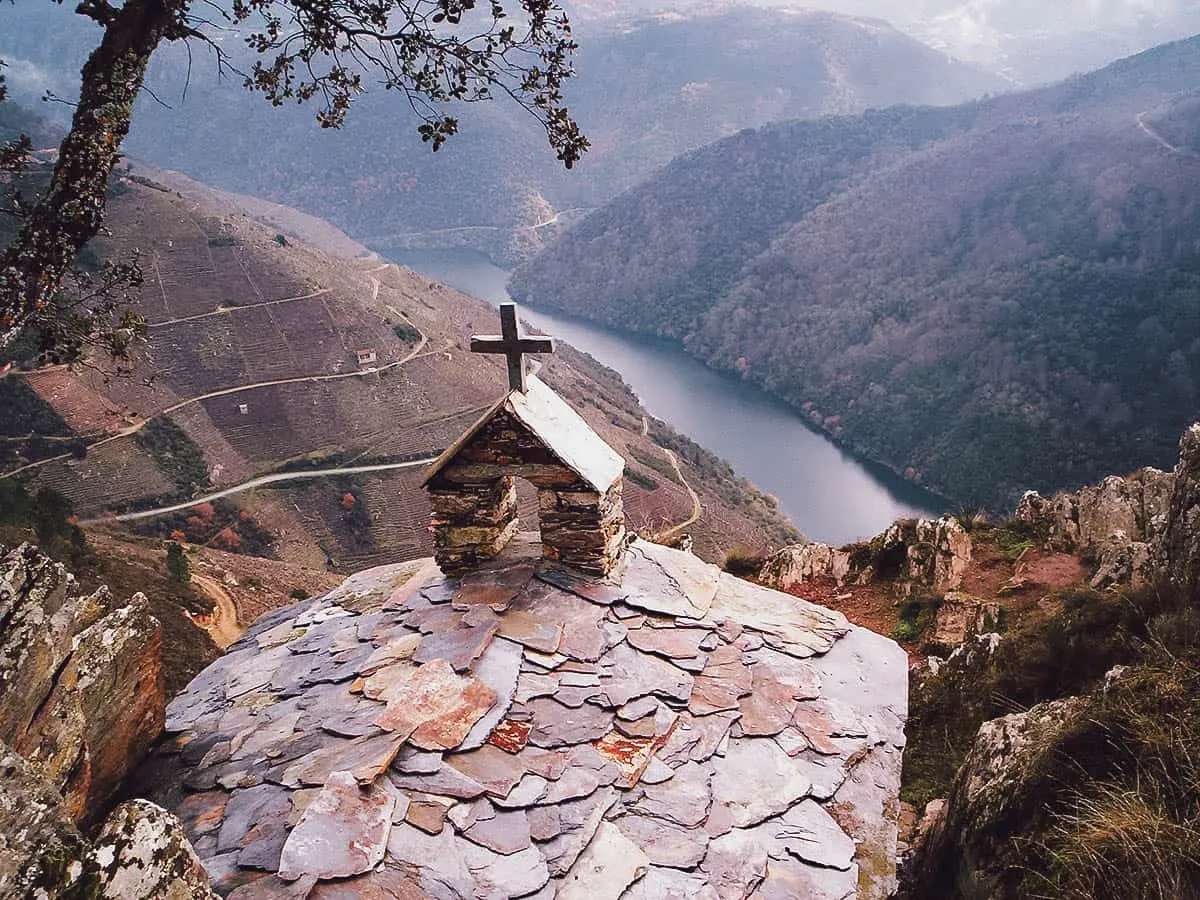
“Ermida sobre a Ribeira Sacra” by Óscar (xindilo/fotosderianxo), used under CC BY-SA 2.0 / Processed in Photoshop and Lightroom
4. Lugo
We made a stop in Lugo on our way to Santiago de Compostela from San Sebastian. It’s known for being the only city in the world surrounded by completely intact Roman walls.
Lugo’s walls date back to the 3rd century and are inscribed as a UNESCO World Heritage Site. They measure between 10-15 meters (32.8-49.2 ft) in height and stretch for about 2,117 meters (6,946 ft). You can walk around the top of the walls in a complete circuit.
Lugo can be reached by bus from Santiago de Compostela in about 2.5 hrs. You can check Trainline or Alsa for tickets. Alternatively, you can rent a car and drive on your own or go on a guided tour.
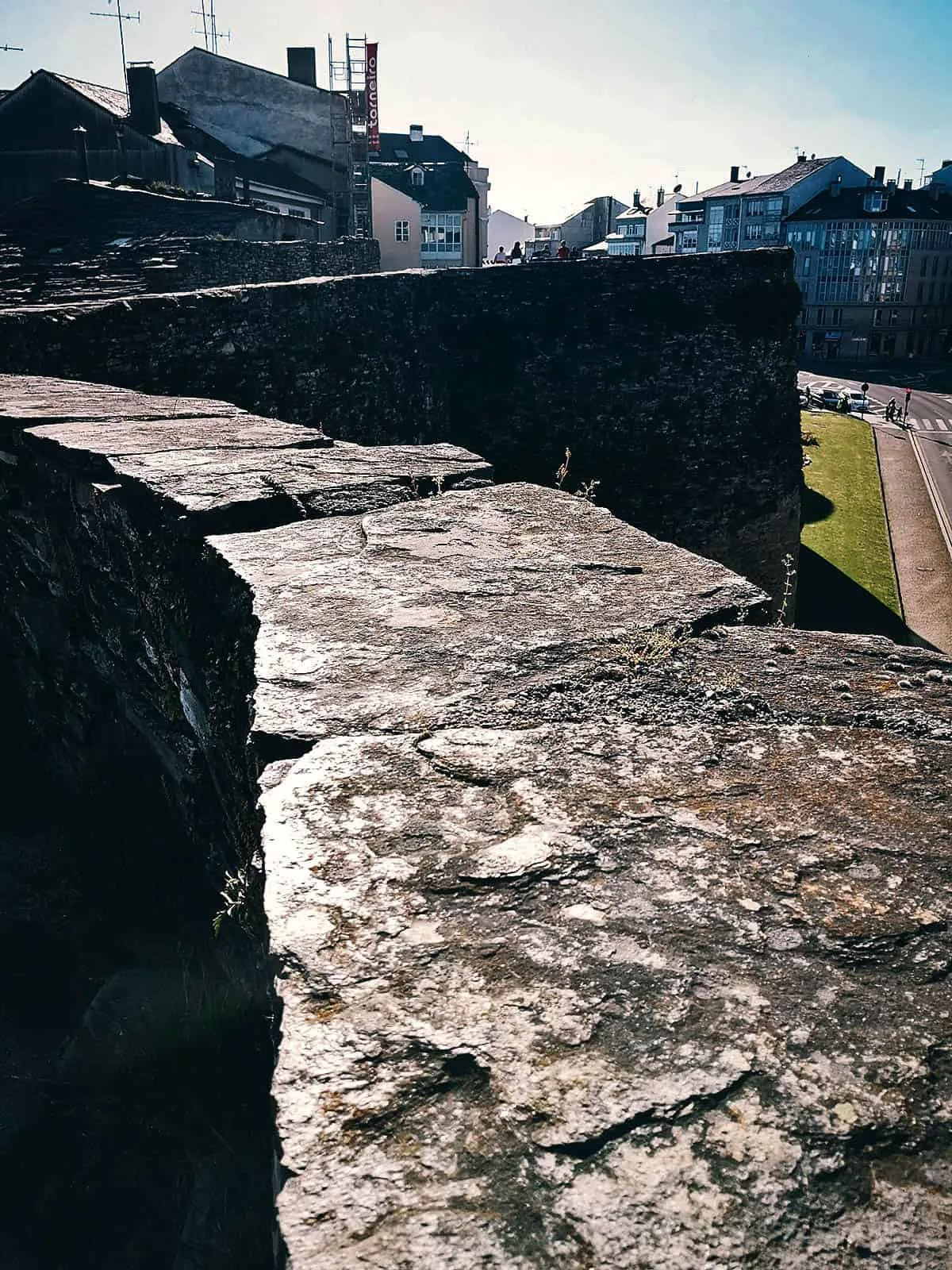
SPANISH FOOD GUIDE
In my opinion, Spain is one of the world’s best countries for food. It’s home to many delicious dishes like paella, tapas, callos, and churros.
If you’re wondering what to eat in Santiago de Compostela, then check out our Spanish food guide for a list of 45 of the most delicious dishes in Spain. If you have an obsession with tapas like we do, then you’ll definitely want to check out our Spanish tapas guide as well.
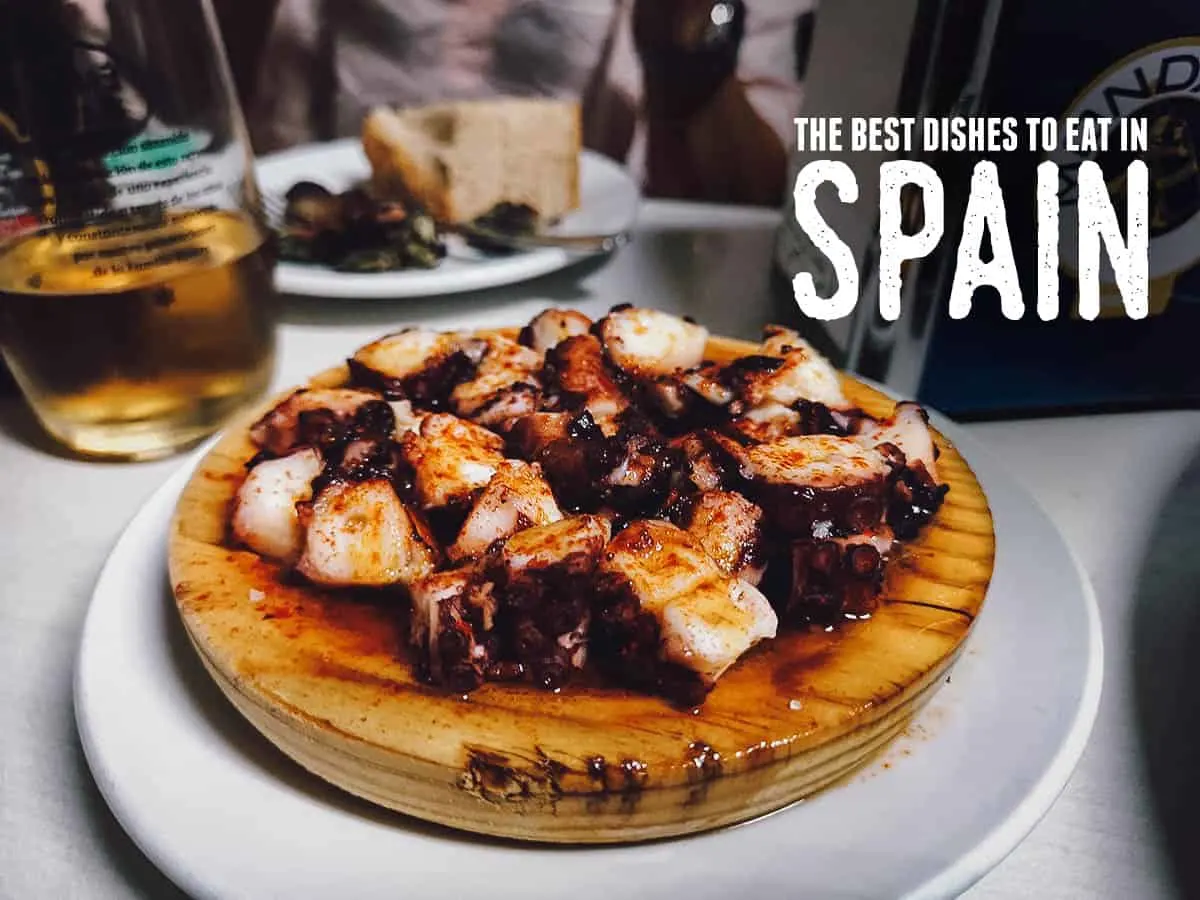
SPANISH DESSERTS
Spanish savory dishes are delicious but so are Spanish desserts. You’ve probably heard of churros con chocolate but check out our article on Spanish desserts for more sweet suggestions in Spain.
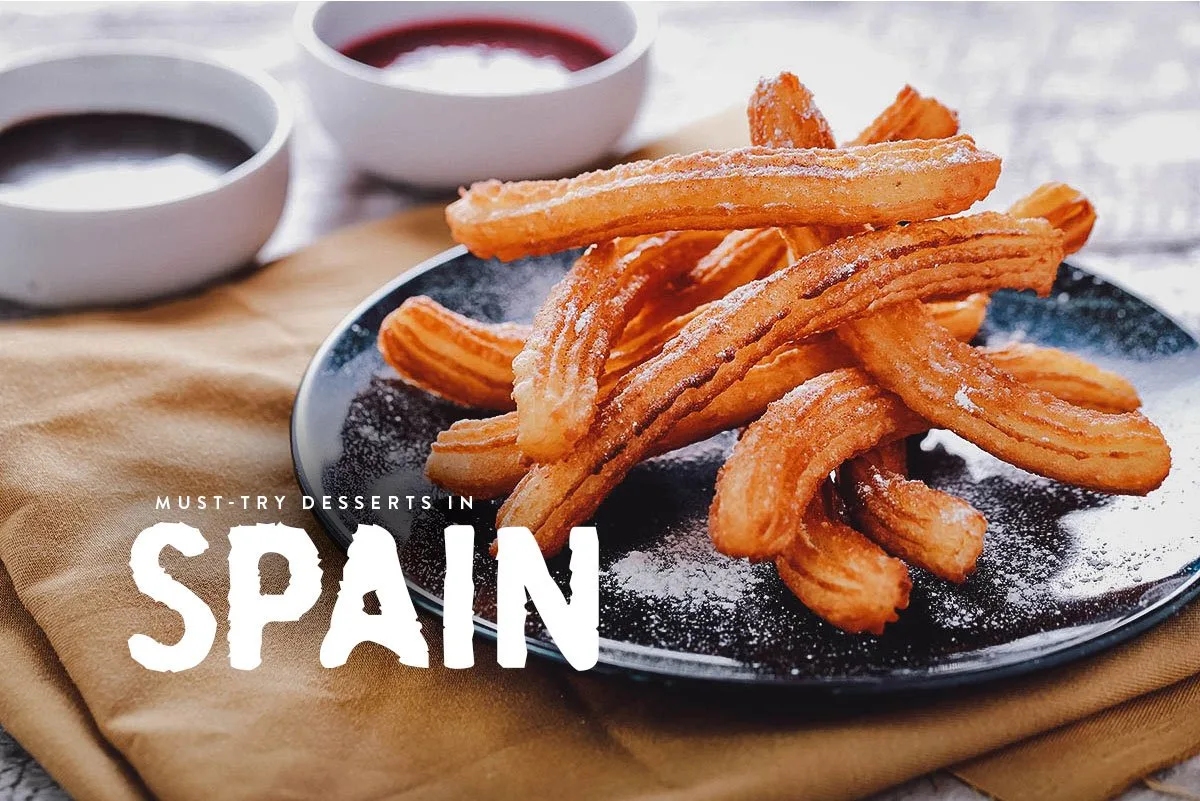
WHERE TO EAT IN SANTIAGO DE COMPOSTELA
1. O Gato Negro
This was one of the main reasons why we visited Santiago de Compostela, to try percebes. Percebes are gooseneck barnacles often referred to as “Lucifer’s Fingers”.
A delicacy along the Galician and southern Portuguese coasts, percebes are ominously nicknamed not just because of their devilish appearance, but because they’re notoriously difficult to harvest. They thrive on craggy rocks in the ocean’s intertidal zone where crashing waves feed them a steady diet of plankton. Farming is impossible so divers have to risk life and limb to harvest them.
Percebes are delicious. Boiled in seawater, they’re similar to sea snails except they’re brinier and with a firmer texture. If you enjoy seafood, then you have to try percebes in Galicia. It’s an unusual regional food that you can’t have just anywhere.
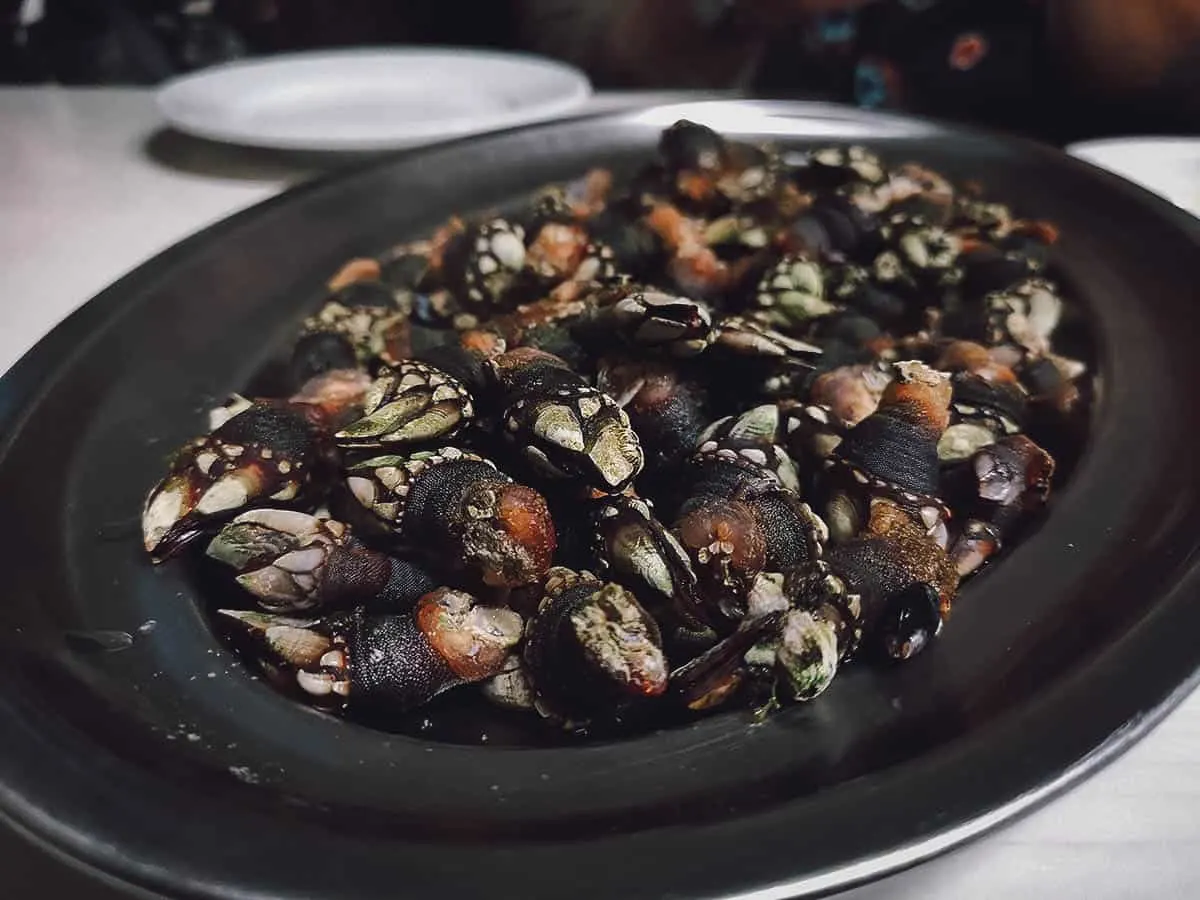
Pictured below is pulpo gallego, another specialty of Galicia. Also known as polbo a feira, it refers to Galician-style octopus boiled to the perfect texture, like al dente pasta.
When ready, it’s chopped up into bite-sized pieces and sprinkled with coarse salt and both sweet and spicy paprika before being drizzled with olive oil. Like percebes, it’s absolutely delicious and a must in Galicia.
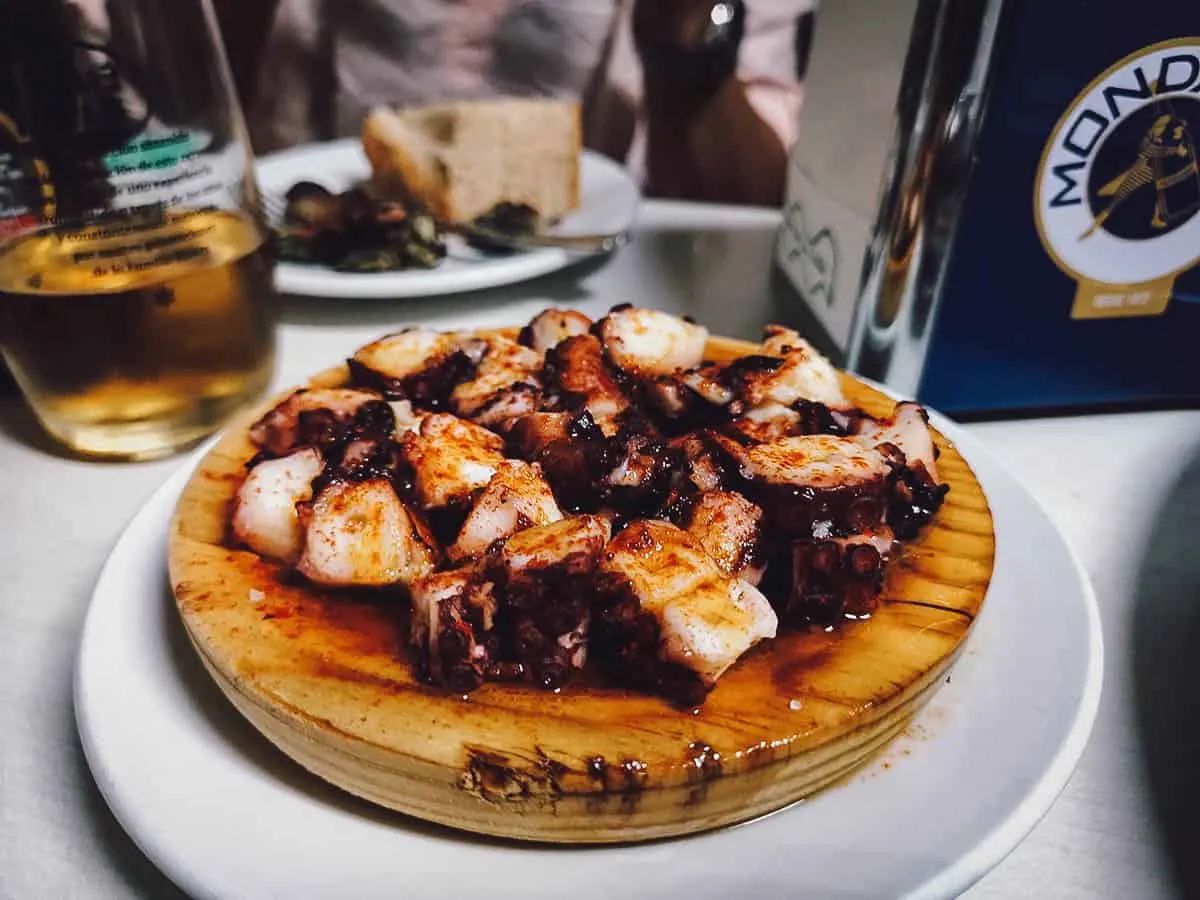
Many restaurants in the Old Town serve percebes and polbo a feira but if you like very local restaurants, then I suggest trying it here at O Gato Negro. It’s a hugely popular restaurant known for serving great Galician seafood.
The restaurant is tucked away in an alley with no clear signage. It’s easy to miss so look out for the crowded tavern with the green door and this hanging black cat (pictured below). The place is very popular with limited seating so it’s a good idea to come early if you can.
We had other tasty dishes as well like mussels in vinegar and baby squid cooked in its own ink. Most of our meals were delicious but this was easily my favorite restaurant in Santiago de Compostela.
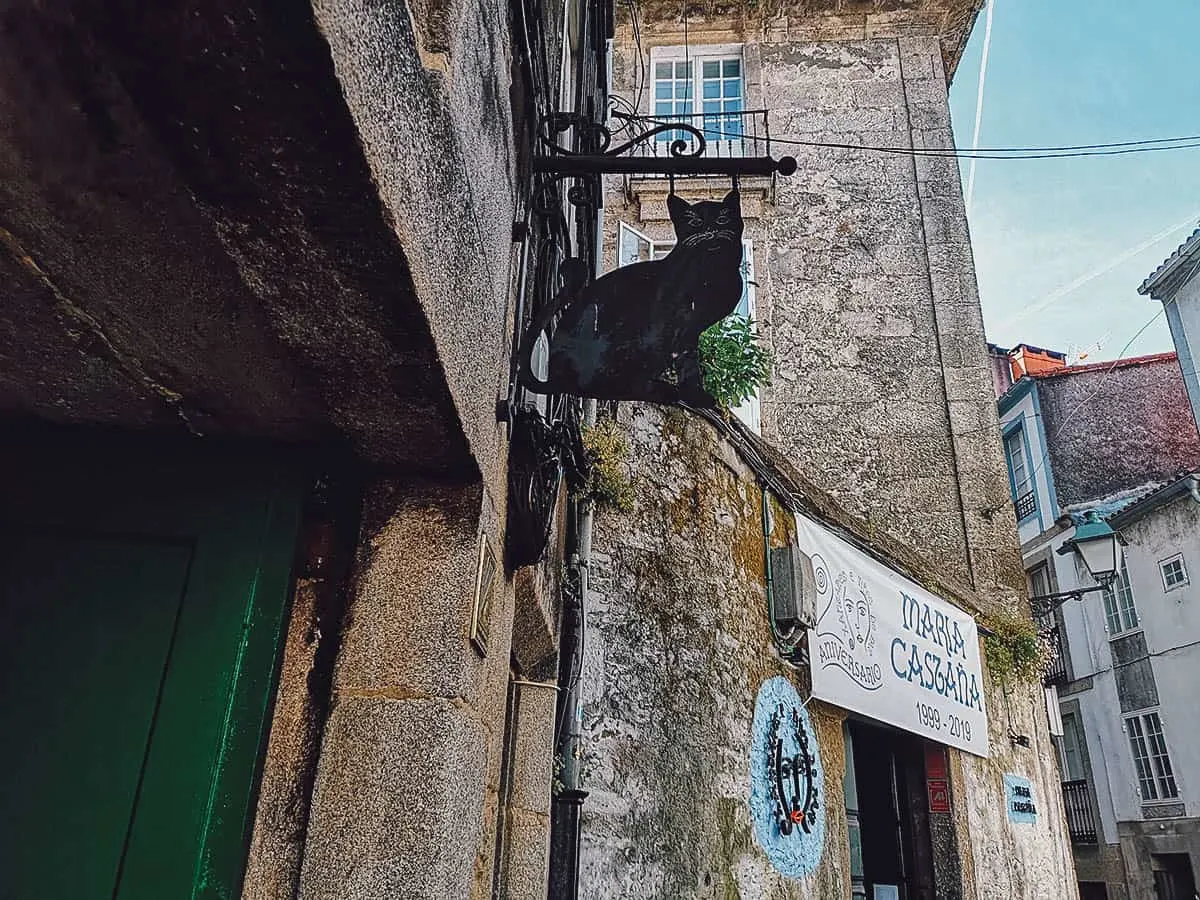
2. A Taberna do Bispo
Like O Gato Negro, A Taberna do Bispo is one of the most popular restaurants we visited in Santiago de Compostela. But unlike O Gato Negro which is more like an informal tavern, A Taberna do Bispo is a slightly more upscale restaurant serving different types of tapas and montaditos (similar to pintxos).
Pictured in the foreground below are montaditos with chistorra sausages and padron peppers. Both are must-try regional ingredients. Padron peppers are from Galicia while the chistorra is a fast-cure sausage associated with Aragon, the Basque Country, and Navarre. Muy delicioso!
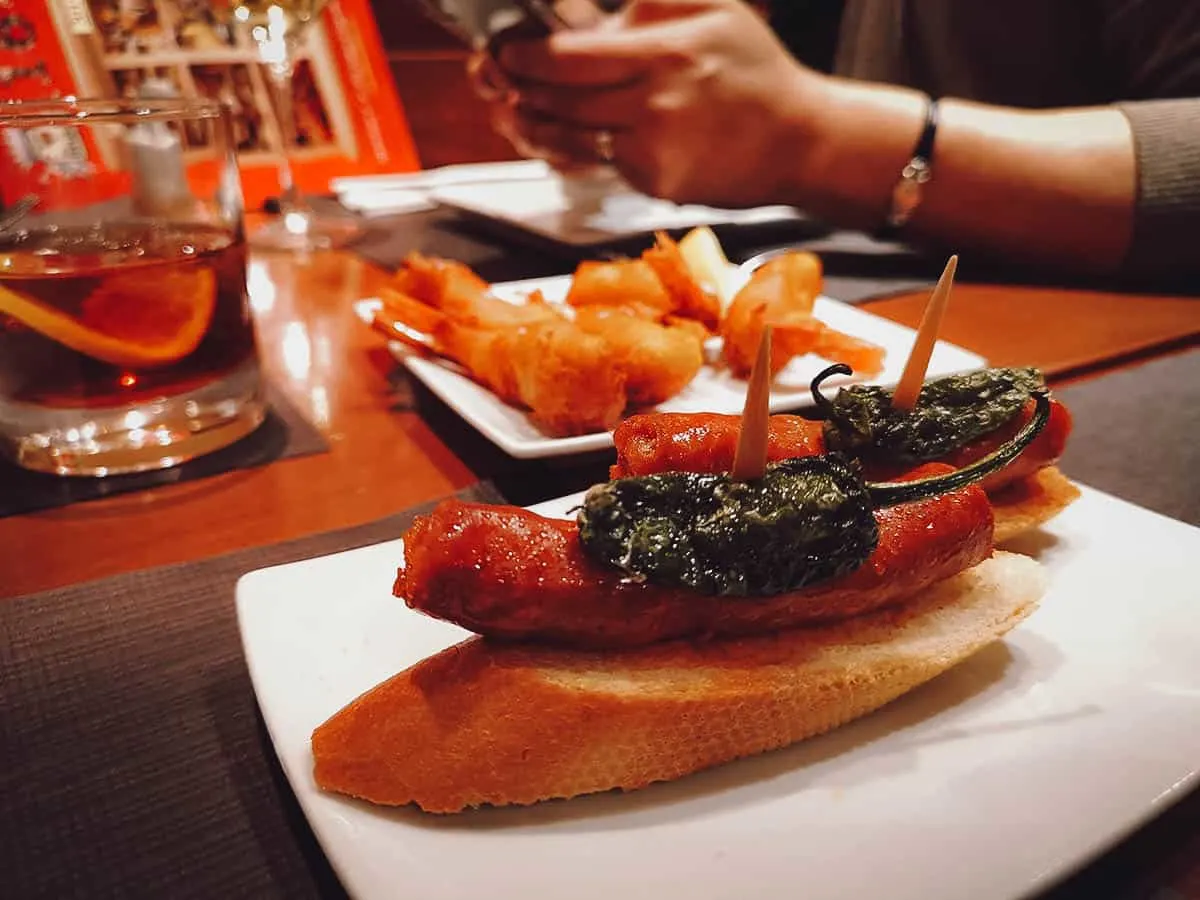
We asked our server for recommendations and he suggested these grilled scallops with shrimp and pesto. Another winner!
We ordered other dishes as well like grilled razor clams and deep-fried battered shrimp. You really can’t go wrong with the seafood in Galicia.
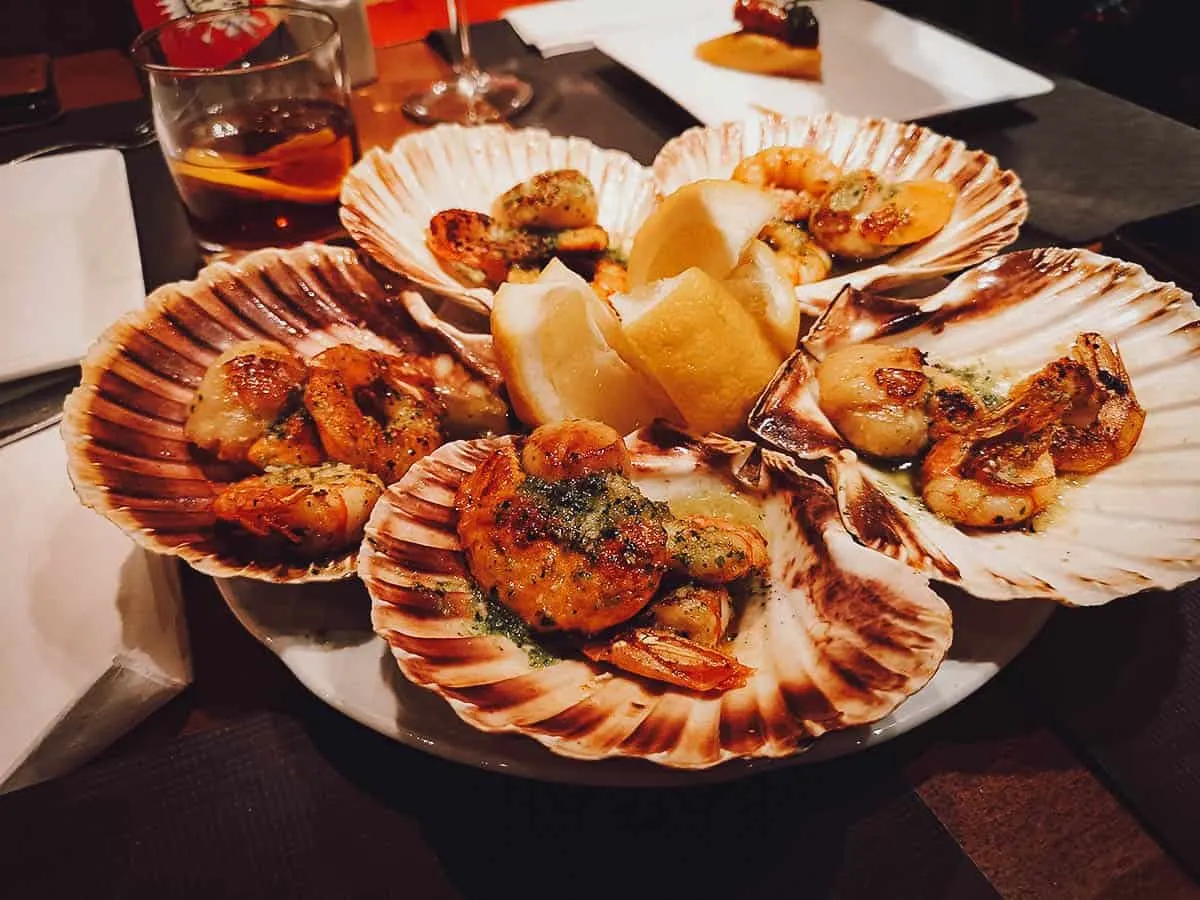
Located in a busy part of the Old Town, A Taberna do Bispo is a Certificate of Excellence awardee with a commendable 4-star rating on TripAdvisor.
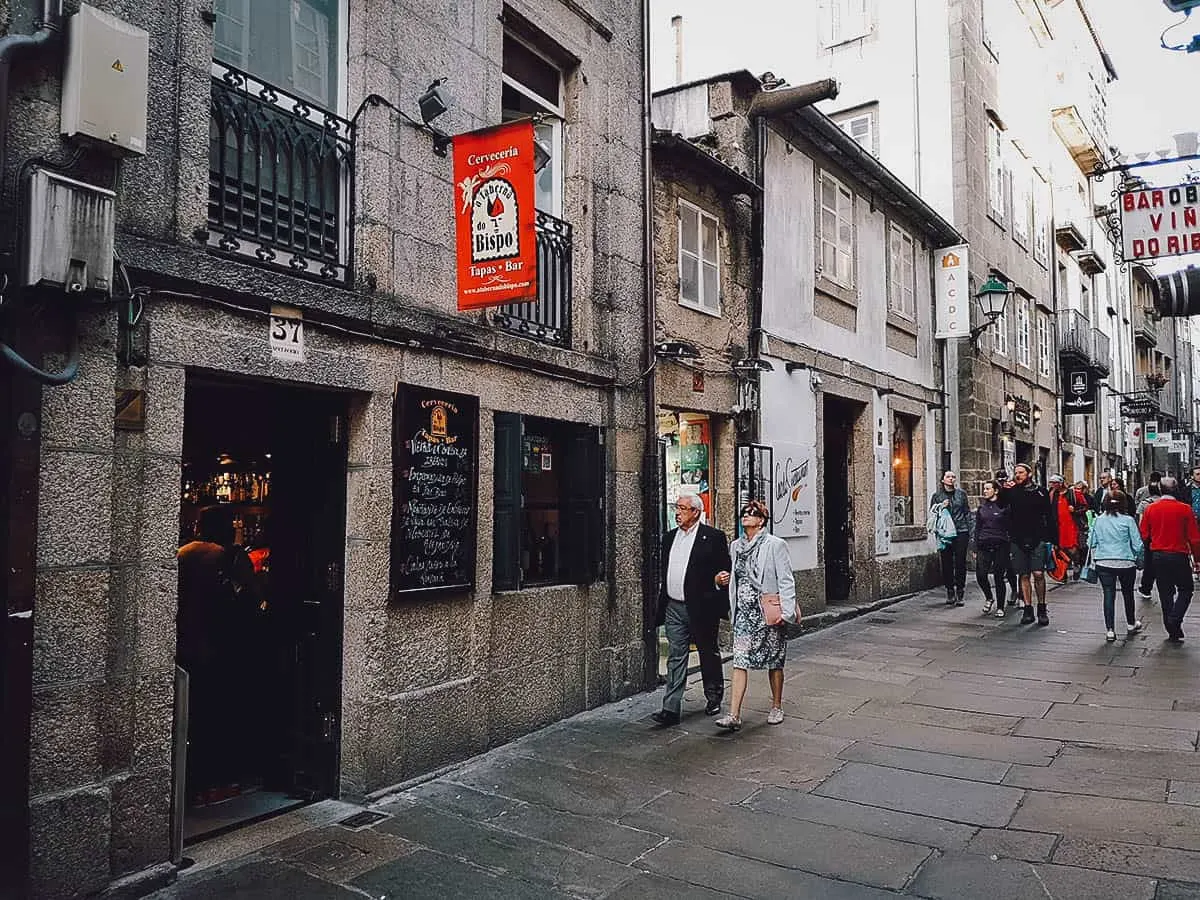
3. Buenjamon
Every time I walk by a jamon shop with stacks of bocadillos in their window, I wind up getting one to go. I can’t resist them, even when I’m not hungry. They’re just so incredibly delicious.
Spanish jamon or dry-cured ham is the best. It’s nutty, sweet, salty, fatty, earthy, and just all around delicious, especially when sandwiched between two halves of a crusty, chewy Spanish-style baguette. To me, this sandwich is perfect. It doesn’t need anything else.
This delicious beast of a sandwich isn’t just a bocadillo de jamon. It’s a bocadillo de jamon iberico de bellota which is the finest grade of Spanish dry-cured ham.
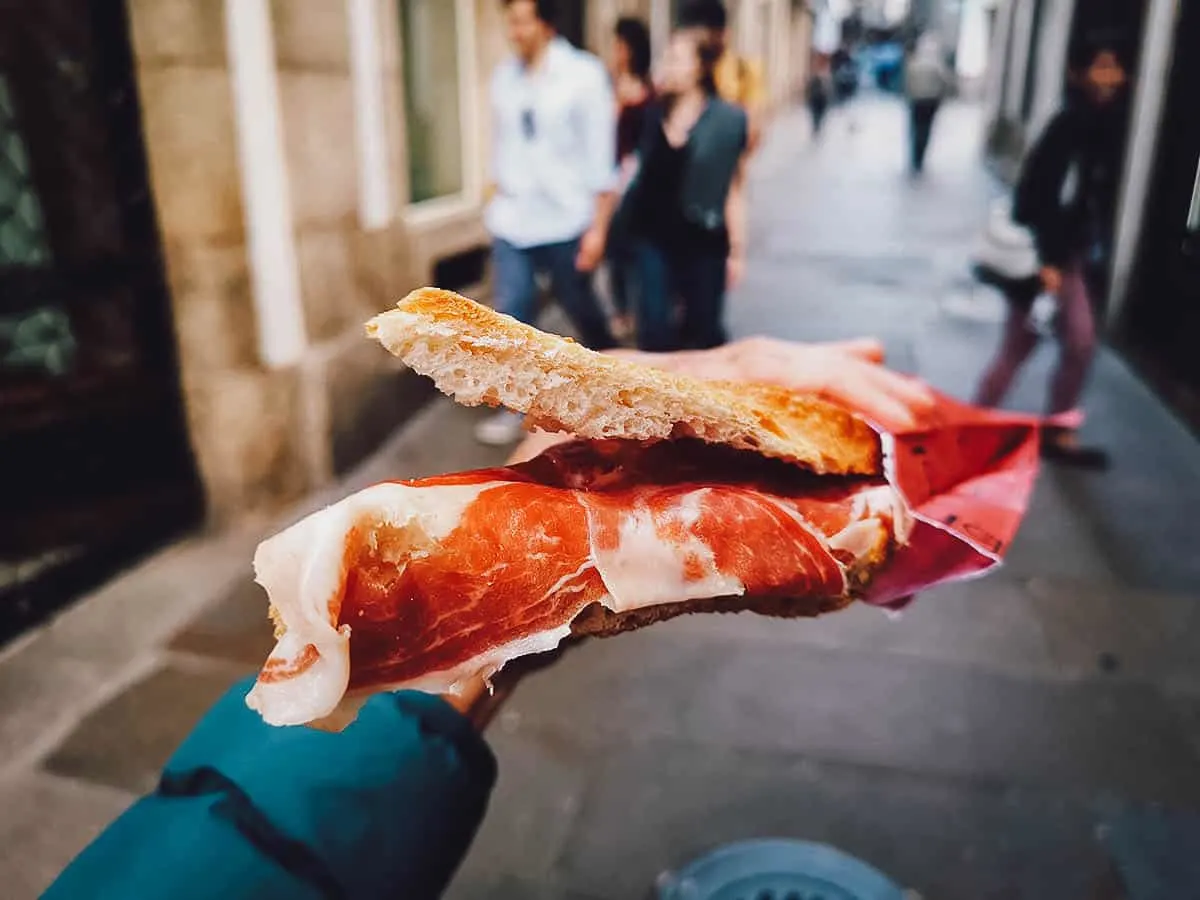
If you’re too full to have a bocadillo, then you can enjoy these cones of jamon instead. Jamon iberico de bellota is made from free-range pigs that roam the oak forests along the Spain-Portugal border.
In their final days, they’re fed a diet of mostly acorns which leads to an incredibly delicious jamon with a smooth texture and high fat content.
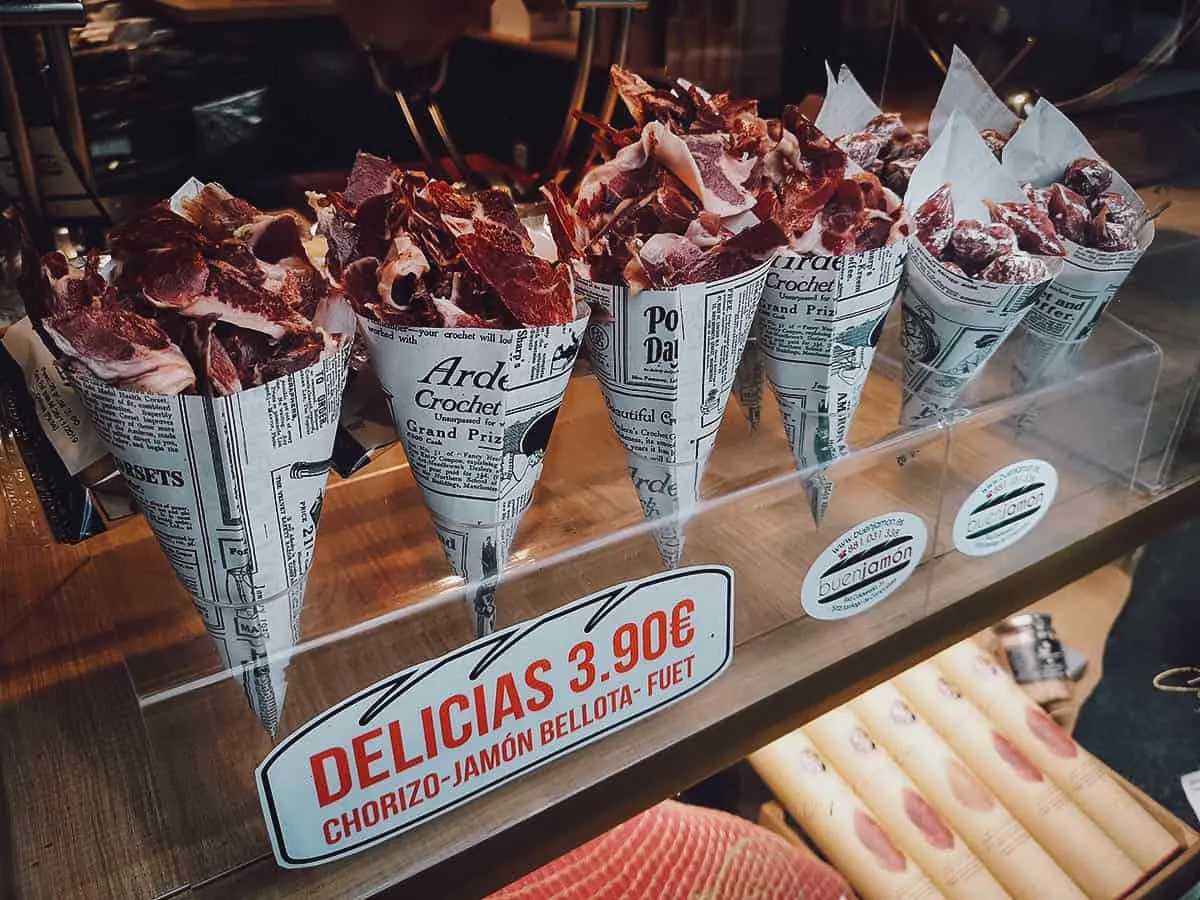
We walked by Buenjamon by chance but I’m glad we found it. Their bocadillo de jamon was fantastic. The majority of Spanish reviewers on TripAdvisor give them an “Excellent” rating.
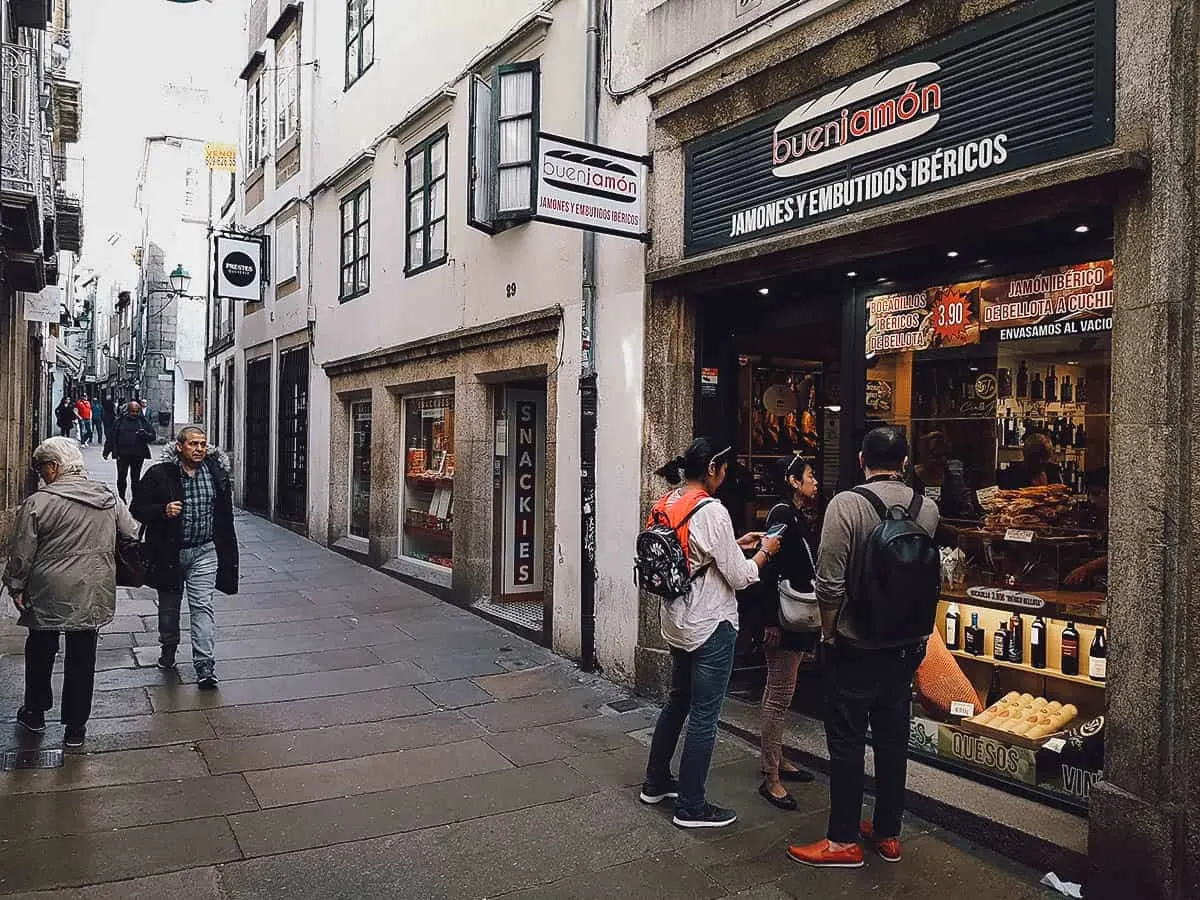
4. Colmado Delicious
Colmado Delicious was another place we found by chance. It’s sort of like an artisanal Spanish deli that makes unique sweet and savory pastries.
Pictured below is an interesting stuffed bread dish that’s reminiscent of a muffuletta, except the fillings are already baked into the bread. If you scroll to the Pinterest image near the top of this article, then you’ll see that it came in the form of a giant loaf stuffed with ingredients like ham, olives, tomatoes, etc.
According to one TripAdvisor reviewer, he asked the owner what it was and he said that it doesn’t really have a name. It’s a recipe that his mother has been perfecting for many years. Whatever it is, it’s absolutely delicious and something we’d love to have again.
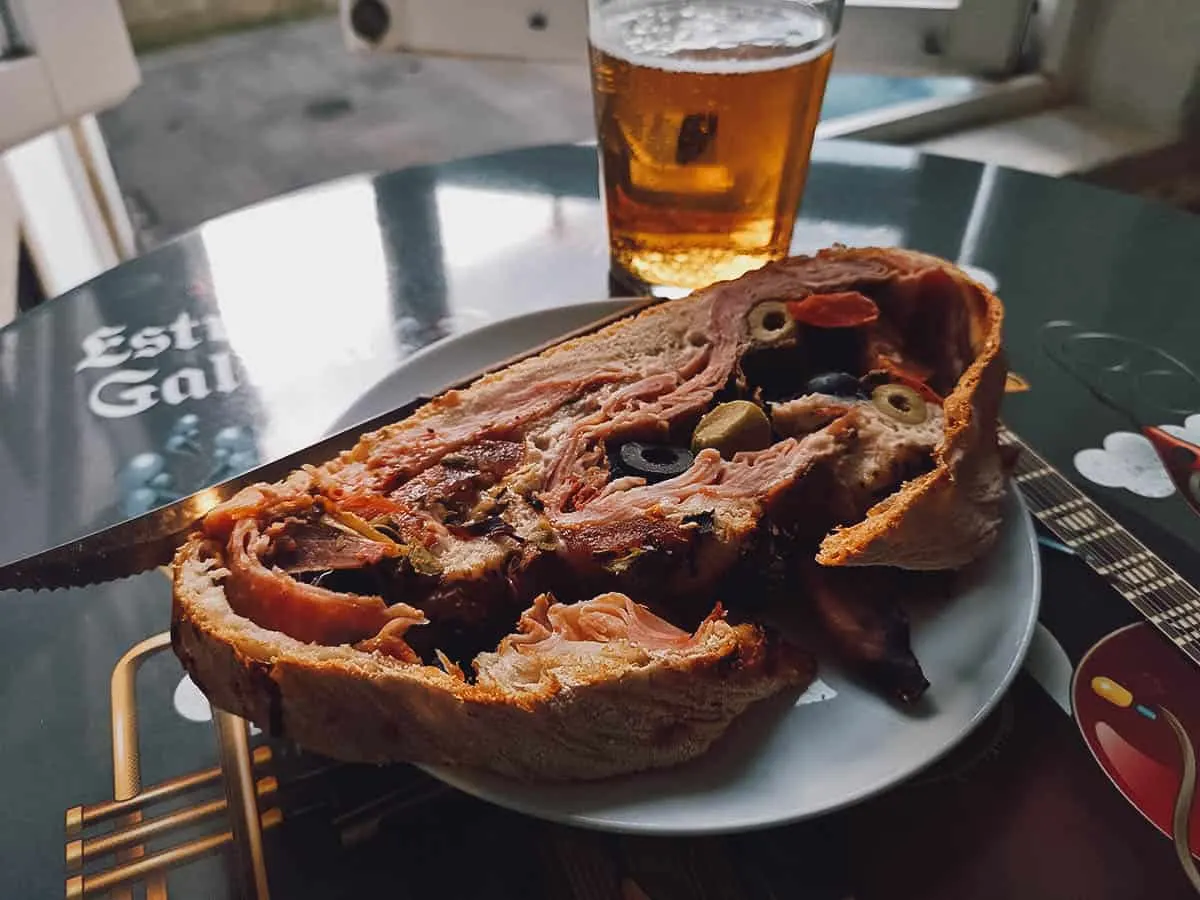
This was another beautiful and incredibly tasty dish we had at Colmado Delicious. I don’t even know how to describe it. It’s basically a stuffed pastry filled with creamy savory ingredients, like a creamy chicken pot pie.
I don’t remember exactly what was in it but I think it had cream, shrimp, mushroom, carrots, and maybe chicken. Again, whatever it is, it’s absolutely delicious.
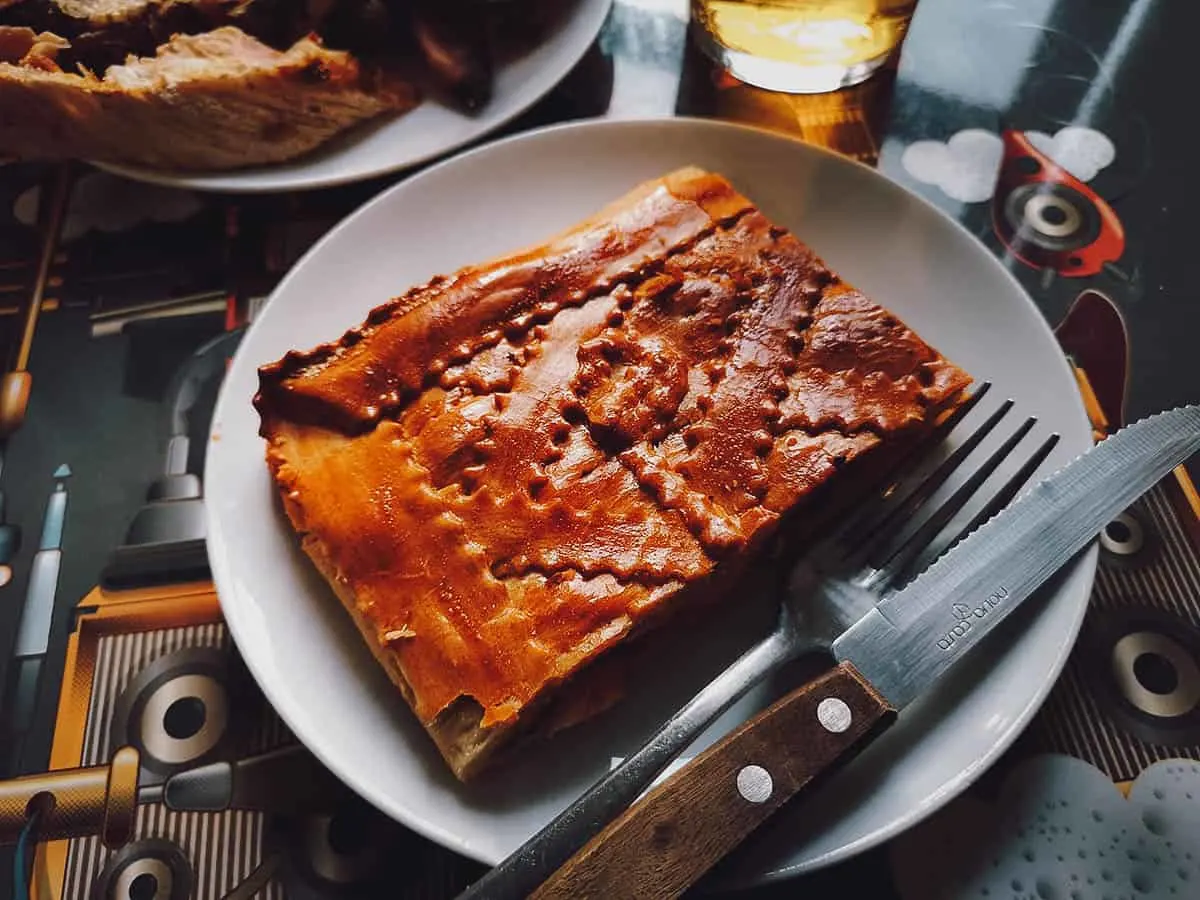
Colmado Delicious has to be one of the more unique eateries in the Old Town. Don’t miss it.
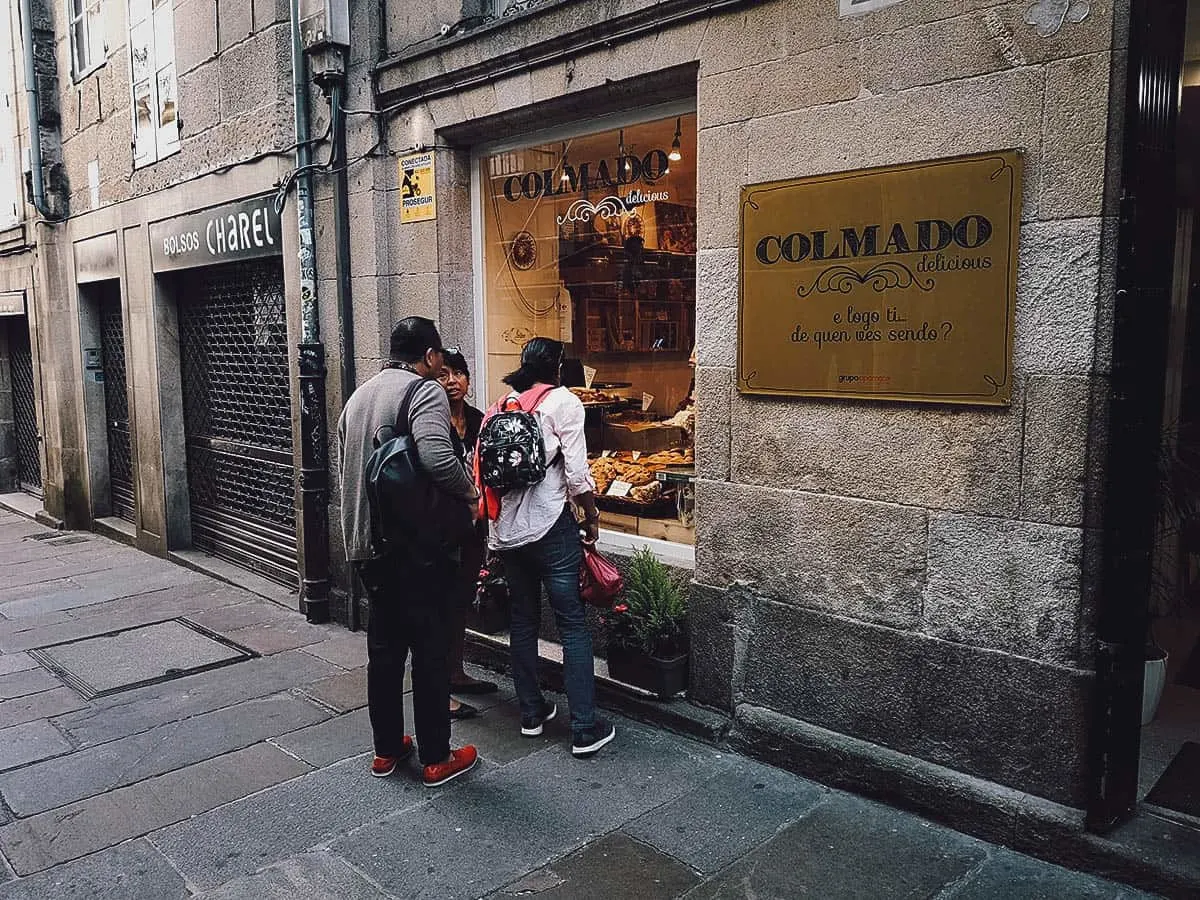
POINTS OF INTEREST IN SANTIAGO DE COMPOSTELA
To help you navigate, I’ve pinned the places recommended in this guide on a map. Click on the link to open the live map in a new window.
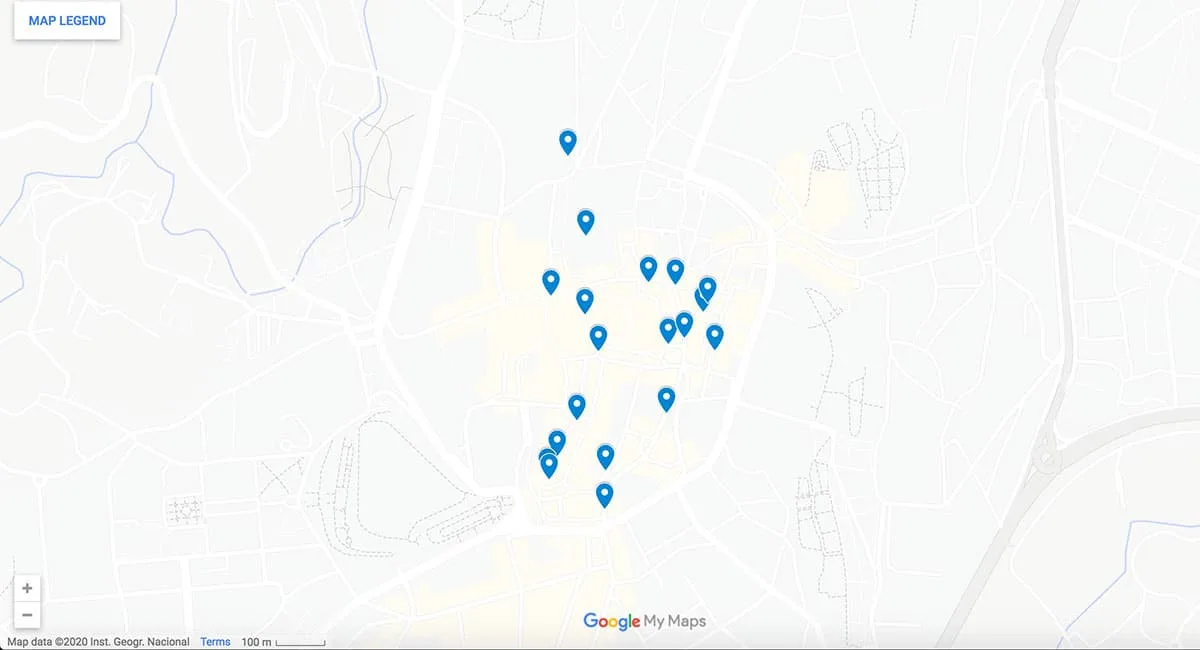
HOW TO GET AROUND IN SANTIAGO DE COMPOSTELA
The Old Town is compact and largely closed off to vehicular traffic so you’ll be exploring it on foot. Unless you’re going on a day trip or beyond the Old Town, then you won’t need any form of public transportation.
To help you navigate, I suggest downloading the Google Maps app (iOS | Android) if you haven’t already. It’ll tell you all the different ways to get from point A to point B, either on foot or using any city’s public transportation system. It’s accurate and reliable and something we can’t travel without.
HOW MANY DAYS TO STAY / SANTIAGO DE COMPOSTELA ITINERARY
Most if not all of Santiago de Compostela’s top tourist attractions are located in the Old Town. It’s compact so you’ll need no more than a day to fully explore it.
I suggest spending one day exploring the Old Town and another day going on a day trip to Finisterre and Muxia. Here’s a sample 2D/3N Santiago de Compostela itinerary to help you plan your trip.
| DAY ONE • Praza de Cervantes • Mosteiro de San Paio de Antealtares • Praza da Quintana • Praza das Praterias • Praza do Obradoiro • Santiago de Compostela Cathedral & Museum • Monastery of San Martiño Pinario • Convento de San Francisco de Santiago |
| DAY TWO • Finisterre • Muxia |
SANTIAGO DE COMPOSTELA TRAVEL TIPS
1. Plan your Trip with Sygic Travel
If you enjoy travel planning like I do, then you’ll appreciate the Sygic Travel app. It’s a free travel planning app that allows me to create detailed trip itineraries. You can download it for free on iOS or Android.
2. Rent a Pocket Wifi Device
Having a reliable connection to the internet is a must these days, especially when traveling. You’ll need it to navigate, translate signs, and stay connected on social media. Having access to Google Maps alone justifies the cost.
We own Pokefi pocket wifi devices so we didn’t need to rent one in Europe. But if you do need a device that works in Spain, then you can rent one through Get Your Guide. You can have it shipped to your hotel in Barcelona or Madrid.
3. Bring Home Tarta de Santiago
We don’t usually buy souvenirs, unless they’re edible. The Tarta de Santiago is a Galician almond cake made with a base of ground almonds, eggs, and sugar. Depending on the baker, additional ingredients can be used like lemon zest, dessert wine, brandy, and grape marc. It’s a recipe that dates back to the Middle Ages.
As you can see below, the top of the cake is dusted with powdered sugar and decorated with an imprint of the Cross of Saint James (cruz de Santiago), hence the name Tarta de Santiago. It’s a moist and delicious cake and the best food souvenir you can buy in Santiago de Compostela.
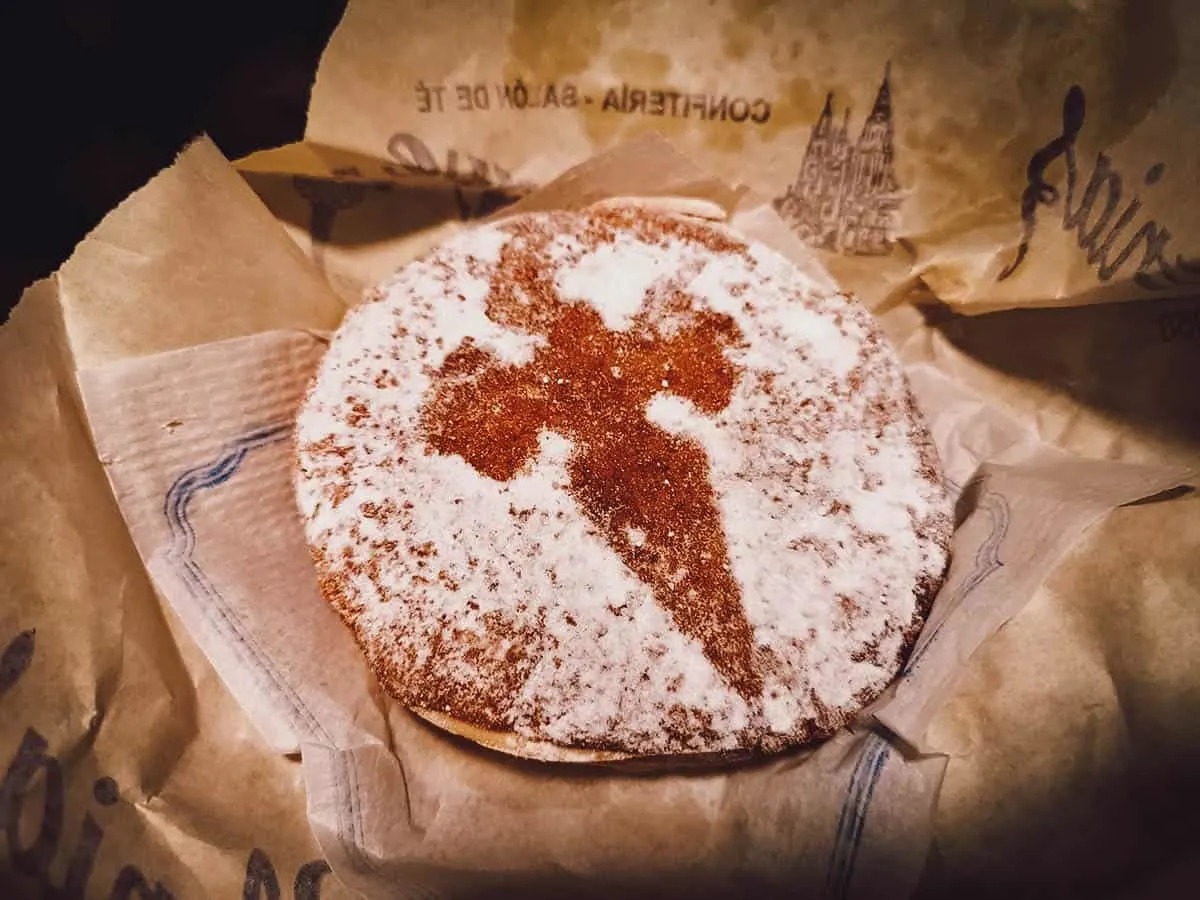
4. Check for Santiago de Compostela Travel Deals
There are many ecommerce websites that sell vouchers to tours and other travel-related services. Among the ones I use, the site that offers the most tours in Santiago de Compostela is Get Your Guide. It’s my preferred platform to look for travel deals in Europe.
5. Rent a Car
Renting a car is one of the best ways to explore Europe. As described, we rented a car to go from San Sebastian to Santiago de Compostela and it was one of the most enjoyable legs of our trip.
If you’re considering renting a car in Spain or anywhere else in Europe, then you can do so through Rentalcars.com.
6. Get Travel Insurance
We don’t always get travel insurance. It depends on where we’re going, what we’ll be doing, and how long we’ll be away for. If we plan on doing any physical activities that could land us in the hospital, then we’ll definitely pick up a policy.
When we do feel the need for insurance, we get it from SafetyWing or Heymondo. They’re travel insurance companies often used by many digital nomads. You can follow the links to get a free quote from SafetyWing or Heymondo. Will Fly for Food readers get 5% off on Heymondo when purchasing a policy through our link.
7. Bring the Right Power Adapter
Spain has Type C or Type F electrical outlets so be sure to bring the right power adapters for your devices. Electrical voltage is 230V and the standard frequency is 50Hz.
Have Fun!
I’m by no means an expert on Spain but I do hope that you find this guide helpful. I’m only sharing some of the things I learned from our trips. If you have any comments or suggestions, then please let us know below.
Thanks for reading and have a wonderful time in Santiago do Compostela!
Disclosure
Some of the links in this Santiago de Compostela travel guide are affiliate links, meaning we’ll earn a small commission if we make a sale at no added cost to you. We only recommend products and services that we use ourselves and firmly believe in. We really appreciate your support as this helps us make more of these free travel guides. Thank you!


Carolin
Monday 31st of August 2020
I walked the minimum of 120km last year on the Camino from Sarria to Santiago. It was one of the best things I’ve done in my life even though I’m not religious, the pilgrimage has restored my I’m imbalanced spirituality. The cathedral is beautiful and it is currently under construction so the pilgrimage mass was held in another church around the corner from the cathedral. I had planned to do the Camino again from Portugal side but the world had other plans.
Carolin | Style Lingua
JB & Renée
Thursday 3rd of September 2020
That's amazing Carolin! I was planning on doing the full camino in 2021 so hopefully the world itself before then. Would really love to scratch that off my bucket list.